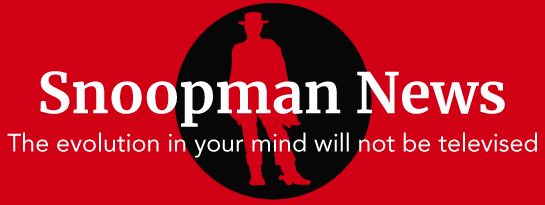New Zealand’s two main political parties protect three mutually reinforcing systems of social control that cast the population as Tax Cattle. The Labour Party continues to gloss over its dark history of deploying an economic warfare framework starting with the Lange Government of 1984. Likewise, the National Party also avoids fessing up about the Bolger National Government advancing this vicious class war from 1990 to 1997. Steve ‘Snoopman’ Edwards presents an un-sanitized account of why, how and who exactly subjected New Zealanders to Shock Doctrine policies that were designed to transform New Zealand into a ‘Switzerland of the South Pacific’ through strategic sabotage. Revealed here for the very first time, former-Lange Ministry Finance Minister Roger Douglas said privately in 1986 that, “in 25 years time, most New Zealanders won’t be able to afford to live here”. These Shock Policies have created a predictable deep structural crisis for Neo-Colonial Capitalism, a huge wealth gap and a Rich Lister Civil Oligarchy that rules unseen in the severely brain-washed, crisis-ridden South Pacific Realm.
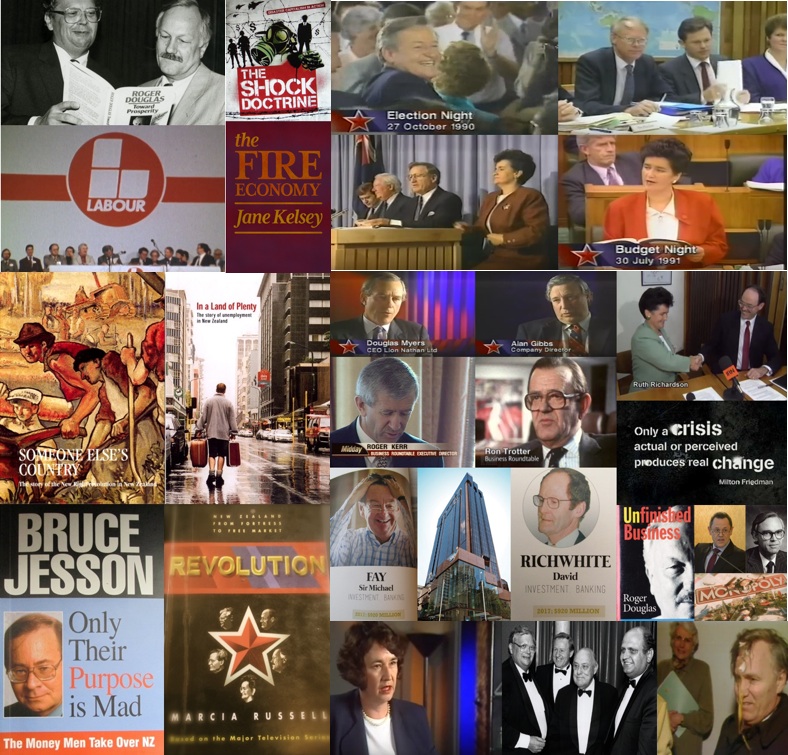
By Steve ‘Snoopman’ Edwards
Human Tax Farming
The New Zealand Labour Party’s three sacred cows are centralized power, capitalism and a debt-based, Tax Cow-backed monetary system.
Centralized power undermines the needs, aspirations and capacity of people to form self-determining communities.[1] Capitalism is a private political system that uses economic means for social control, and its hidden purpose is to limit as many people as possible from gaining access to land.[2] This means capitalism circumvents indigenous mass land redistribution, which is a necessary component to forge self-determining communities. Debt-based monetary systems are controlled by financial authorities, transnational banking consortiums and dynastic banking families, who maintain a universal scarcity of cash, so that families, businesses and governments are coerced to ‘borrow’ manufactured credit into existence.[3] The vested interests that benefit from this debt enslavement system have everything to lose from a community banking system that produces debt-less, interest-free cash and credit, or positive money, for public projects and private enterprise.[4]
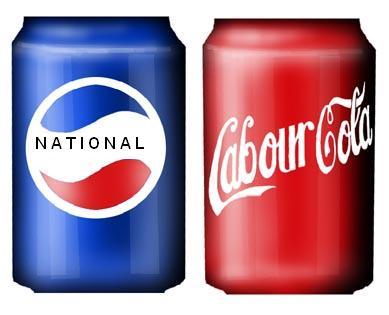 These three sacred cows of Labour Cola are, in effect, Pepsi National’s elephants in the room. Centralized power, capitalism and a debt-Tax Cow enslavement system work together to curb bona fide freedom.
These three sacred cows of Labour Cola are, in effect, Pepsi National’s elephants in the room. Centralized power, capitalism and a debt-Tax Cow enslavement system work together to curb bona fide freedom.
Because the globally spread franchise of democracy is capitalism’s administrative system, it follows that the Westminster Parliamentary system – which grew out of the world’s oldest privately owned municipality, the City of London Corporation – is hardly emancipatory.[5] In fact, it is a system for the perpetuation of Human Tax Farming.[6]
Glossing Over Labour Party History
When Jacinda Ardern held her first press conference as leader of the Labour Party, she claimed her political party had always worked for a “better and fairer New Zealand”.[7]
This is not true, as the writers for the Redline blog makes abundantly clear.[8]
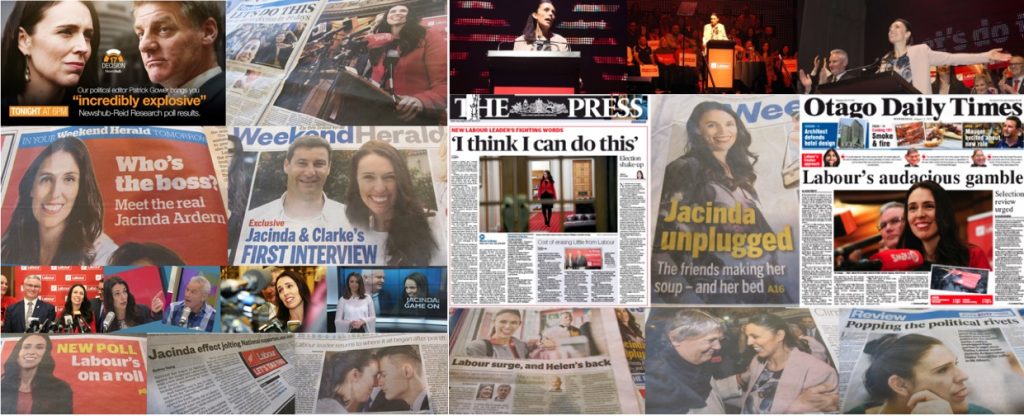
Indeed, the deployment of ‘free market’ shock policies by the Lange-Labour governments of the mid-to-late 1980s are a case in point, particularly as a deeper understanding of the planning that underpinned them has been reached by researchers.
A critical scrutiny of the key players involved in the shock policies show that the Lange-Labour government deliberately deployed an economic warfare framework to favour their Big Business Beneficiary donors and associates.[9] A political-bureaucratic-economic coup took place in mid-1984 centred on the capture of the David Lange government immediately after the election win of the Labour Party on July 14. New Zealand’s currency had been speculated against during the election campaign, following shadow finance minister Roger Douglas’s distribution of a paper stating that he would substantially devalue the currency if Labour became the government.[10] The business community knew Douglas’s position.[11] The currency crisis was used as a mechanism of coercion upon the Lange government in-waiting to submit to the advice of Reserve Bank and Treasury officials. In turn, the atmosphere of crisis was used to gain the submission of the governed via a contagion of fear spread in ‘the news’.
This speculative activity cost New Zealand taxpayers $1.7 billion. Although Reserve Bank officials such as Dr. Roderick Deane knew who was trading against currency, he did not whistle blow to divulge who had made sure bets against the currency, and how much profit they made, knowing its value would drop once the Lange government was formed. Such information would have yielded valuable information about the milieu of conspirators behind the 1984 political-economic coup. In 1996, Deane only divulged that the then-state-owned Bank of New Zealand had been among the institutions that had bet against New Zealand’s currency, as Marcia Russell found while producing a documentary series that she turned into a book, Revolution: New Zealand from Fortress to Free Market.
Filmmaker Alister Barry’s documentary’s, Someone Else’s Country: The Story of the New Right Revolution in New Zealand and In a Land of Plenty: The Story of Unemployment in New Zealand, as well as the four part series, Revolution, show that the Lange-Labour governments elected in 1984 and 1987 clearly had no mandate to pursue ‘free market reforms’. Works such as: Jane Kelsey’s The New Zealand Experiment (1995); Bruce Jesson’s Only Their Purpose is Mad and the aforementioned documentaries; show that Treasury had in the lead-up to 1984 and 1987 elections written blueprint policy documents, ‘Economic Management’ and ‘Government Management’, respectively. Those blueprints envisaged the policy shocks required to transform New Zealand from a socialist welfare state to a capitalist state.
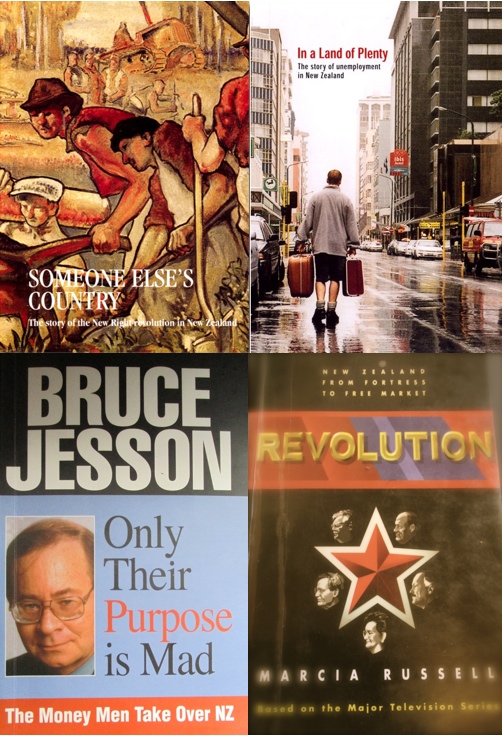
In her 2015 book, The FIRE Economy,[12] Jane Kelsey locates former Lange Government finance minister Roger Douglas’s ‘blitzkrieg strategy’ in the kind of Shock Doctrine crisis scenarios described by Canadian journalist Naomi Klein in her groundbreaking study, The Shock Doctrine. Klein’s book investigates an economic warfare framework that was based on the concept of ‘speed, suddenness and scope’, This concept was a mantra that a University of Chicago’s Department of Economics professor, Milton Friedman emphasized to his students who were among the many economic missionaries who spread ‘free market’ shock policies around the world. Indeed, Friedman happily performed the function of a globe-trotting Shock Doctor teaching his modus operandi wherever he went. Friedman made his first visit to New Zealand in 1981, the result of an invitation from such people as Don Brash, before he became Reserve Bank Governor.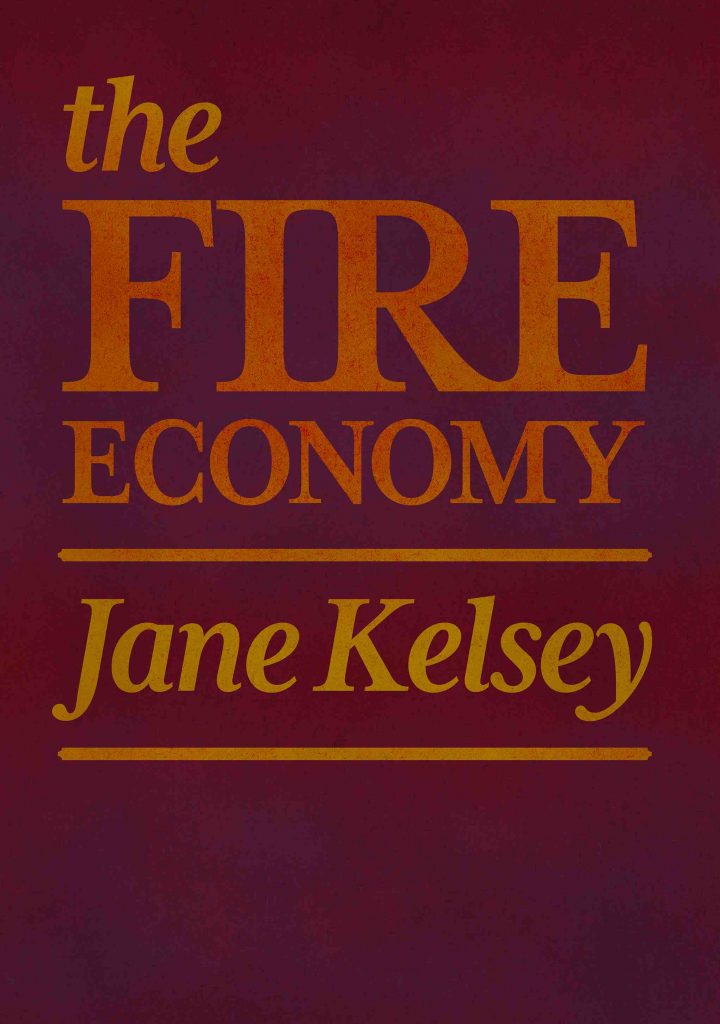
Central to the ‘free market’ system is ‘shock treatment,’ which means rapid far-reaching changes to the political economies of countries through the sudden implementation of neoliberal policy shocks. Indeed, policy shocks often occurred when governments and their central banks had been confronted with a wide range of crises, usually in the form of a currency, banking or sovereign debt crisis.
This Shock Doctrine economic warfare framework is designed to benefit Rich Listers – foreign and domestic, because the brunt of ‘free market reforms’ is borne by the 99%. Meanwhile, the ‘property rights’ of the super-rich are protected in the parallel universe that is the Worldwide Tax Haven Complex.[13]
Therefore, the political theatre played in the New Zealand Tax Farm is that both major political parties – National and Labour – avoid fessing up about this little known economic warfare framework that the Crown manages, no matter which party ‘governs’.
On 20 August 2017, at the Labour Party campaign launch Jacinda Ardern said to her supporters at the Auckland Town Hall, there was no time to waste on working out who is to blame for the multiple crises that beset New Zealand. Ardern’s assertion is an appeal to one of the West’s most dominating, anti-intellectual and bunk philosophies: pragmatism.
Thus, the policy prescriptions of Coca Cola Labour and Pepsi National parties are mere tinkerings with the same ‘free market’ project: Neo-Colonialism.
Neo-Colonialism is the hidden construction of vast monopolistic transnational consortiums owned by super-wealthy people who are positioned atop the Transnational Capitalist Class to control whole economies.[14]
Switzerland of the South gets the Shock Doctrine Treatment
New Zealanders would find it shocking to learn that the so-called policy failures of the last three decades were deliberate and therefore the ‘failures’ were by design.
Indeed, in December 1986, then-Finance Minister Roger Owen Douglas stated in a private conversation that the intention behind the ‘free market’ reforms was to create a ‘Switzerland of the South Pacific’ ruled by a rich elite. Douglas also confided that most New Zealanders would not be able to afford to live in New Zealand in 25 years time.
That would have been 2011.
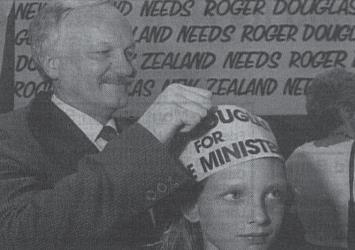
Five years later, in August 2016, the ‘City of Sails’ recorded a jump in average house prices to $1,000,000 from $500,000 10 years earlier, which meant that house prices had grown an exponential rate of 7% per year over a decade. Applying the doubling time concept at the 7% annual growth rate – and with all factors staying constant – Auckland’s average house price would double again in just 5 years, reaching $2m in August 2021, and $8m in May 2025!
Not surprisingly, at the beginning of 2017, London-based Bilderberger Group mouth-piece,[15] The Economist magazine reported New Zealand is ranked as the most unaffordable place to live in the world.[16] Indeed, the bottom 1% or 42,000, were so poor they were classified as homeless,[17] while the top 10 percentile of the 1% were so rich, the National Business Review reported their wealth to be $55.84 billion.[18] When asked in that private conversation way back in December 1986 how it could be possible that New Zealanders would find themselves out-priced in their country, Roger Douglas answered that it would be mostly driven from overseas – particularly China.
Publicly, merchant bankers Michael Fay and David Richwhite, who floated a company in December 1986 called European Pacific that they based in the wealth secrecy haven of Luxembourg, also spoke about transforming New Zealand into a ‘Switzerland of the South Pacific’ during the mid-1980s. Ironically, after Fay and Richwhite’s credibility plummeted following the Cook Islands ‘Wine Box’ tax evasion scandal in the mid-1990s when European Pacific’s exploitation of the jurisdiction as a tax shelter came under scrutiny, the state-raiding accomplices became ‘tax-exiles’ in the Knights Templar Federal Republic of Switzerland in 1998[19] – after selling their mansions for the fraternally-symbolic sum of $13 million.[20]
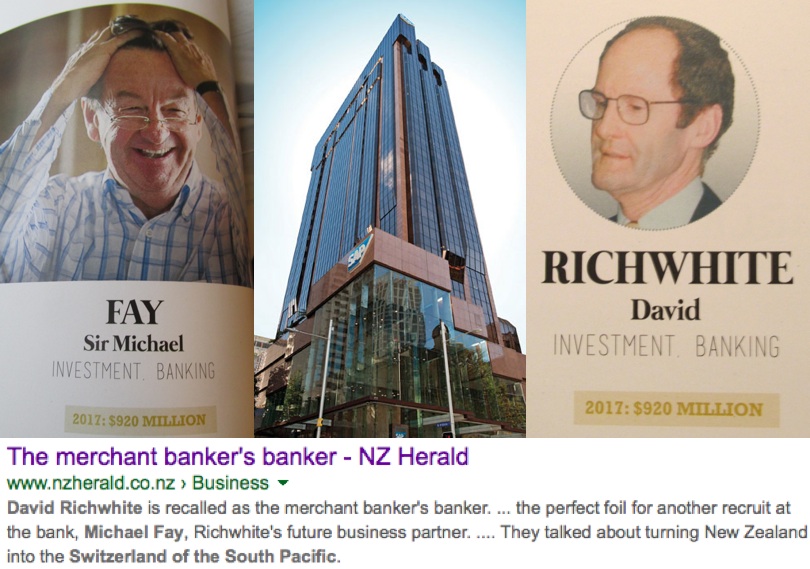 Reflecting a Switzerland of the South Pacific Vision? Formerly known as Fay Richwhite Tower, the skyscraper was merchant bankers’ brazen statement that New Zealand’s oligarchy, and their foreign associates, had taken over the economy.
Reflecting a Switzerland of the South Pacific Vision? Formerly known as Fay Richwhite Tower, the skyscraper was merchant bankers’ brazen statement that New Zealand’s oligarchy, and their foreign associates, had taken over the economy.
Therefore, in public, Douglas was playing the role of a free-market reforming sooth-sayer, claiming that the benefits of the reforms would ‘trickle down’ to everyone, but that the rich were still needed. The sell – replicated around the world – was that after some sacrifices, everyone would prosper. Meanwhile, in private Douglas was confiding, in effect, that the plan was to create a super-rich oligarchy that would be protected by financial secrecy laws. Therefore, the Trickle-Down effect was a wryly-encoded joke that the wealthy would control the tap.
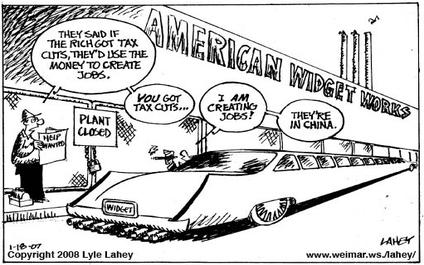
The groundwork for the stealthy deployment of ‘free market economic shock treatments’ in New Zealand started when Robert Muldoon was finance minister in the Holyoake-National Government.[21] In 1971, Muldoon succumbed to intense lobbying from the Broadlands Dominion Group to allow foreign firms access to merchant banking. Five merchant banks with foreign ties – including Broadbank headed by Don Brash, which was formed in a joint venture with Wells Fargo Bank, and Chase-NBA New Zealand, headed by Alan Gibbs – soon emerged.[22] Gibbs and Brash developed an offshore market in New Zealand dollars at a time when currency speculation was being pioneered to take advantage of the successful Wall Street-City of London financial-political coup in which the strings of the Rockefeller-puppet President Nixon were pulled to un-peg the US dollar’s convertibility from a stable value of gold.[23]
Under Robert Muldoon’s watch as Prime Minister (1975-1984), the gaming of New Zealand advanced with large industrial development ‘loans’,[24] liberalizing regulatory controls over the share market,[25] and legislating voluntary union membership.[26] Muldoon led a virtual double-life as chairman of the International Monetary Fund and the World Bank board of governors in 1979 and1980,[27] which placed him in a position to ‘borrow’, and symbolically signaled New Zealand was about to become the First World’s pre-eminent Shock Therapy test lab – without him necessarily knowing it. The Neo-Colonial ‘Free Market’ Sect tried to get Muldoon to implement their plans to de-regulate and privatize the economy in 1979, but the second round of the Oil Price Shocks saw Muldoon hunker down and tighten his control over the economy.[28]
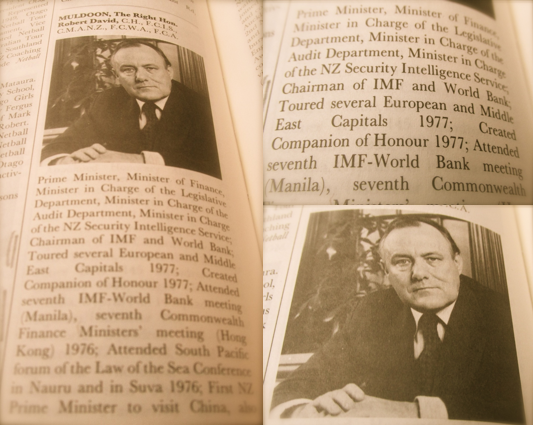
By 1984, New Zealand’s total foreign debt was $12 billion, which primed the state apparatus for coercion to submit to the ‘free market’ policy shocks engineered from abroad and from within.[29] Capitalists shifted financial support from National to Labour for the 1984 election. Property tycoon Robert Jones, who always claimed he alone bank-rolled the New Zealand Party, drew votes away from National in order help get Labour elected, ostensibly because Muldoon’s Wage/Price Freeze since 1982 had harmed property speculation.
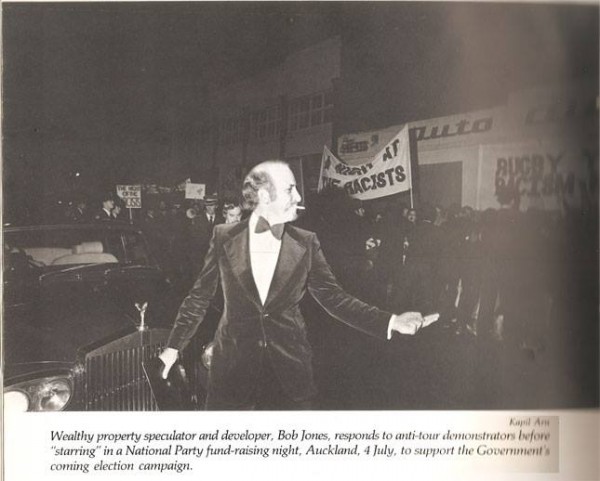
The Reserve Bank and Treasury claimed month-long speculative attack on the New Zealand dollar ‘forced’ the institutions to borrow $1.7 billion to prop up the value of the currency. Although Reserve Bank officials such as Rod Deane said it was outrageous that the currency crisis was suppressed, he knew who was trading against currency. Deane did not whistle blow to divulge who had made sure bets against the currency, nor how much they made on the knowledge its value would drop once the Lange government was formed.[30] Such information would have yielded valuable information about the milieu of conspirators behind the 1984 political-economic-bureaucratic coup. In 1996, for the documentary Revolution, Deane only divulged that the then-state-owned Bank of New Zealand had been among the institutions that had bet against New Zealand’s currency.

Very tellingly, in 1996 former David Lange gave away his cunning for perception management and the conspiracy inherent to fuelling the speculative attacks on the currency when he recalled his government in-waiting taking advice – that breached the law – on managing the crisis. Lange spoke of “legitimizing the crisis”, saying:
“[w]e talked quite seriously about getting the IMF in. I wanted to get the receivers in. I heard of it being done by Western Samoa some years before and it seemed to me that we had to legitimize the crisis by making it seem to be a non-partisan invention.”
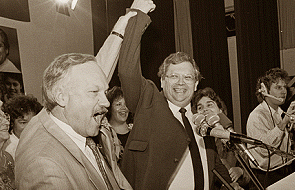
Power by Deception: Tasman Institute member Roger Douglas and PM-elect David Lange feel the rush that psychopath’s relish: winning the confidence of their intended victims.
The Governor of the Reserve Bank Spencer Russell added to the emotional atmosphere of crisis by keeping the Reserve Bank closed on the Monday following the election. This provided an excellent opportunity for TVNZ reporter Richard Harman to interview both Muldoon and Lange that evening. Political actor Muldoon could be relied upon to be stubborn, while political actor Lange could be relied upon to be eloquently cutting. Both politicians, whose offices were only 40 metres apart, were engaged in a “strange dialogue of the dead”, as Lange recalled. The effect was a game of dysfunctional political theatre on national television played by night, that added an atmosphere of a constitutional crisis to a financial crisis, and worked to slyly displace any logical thought about why the government apparatus was not talking like mature grown-ups by day.[31] In short, the key perps created an emotional contagion by exploiting fear, or a fear emoscape.
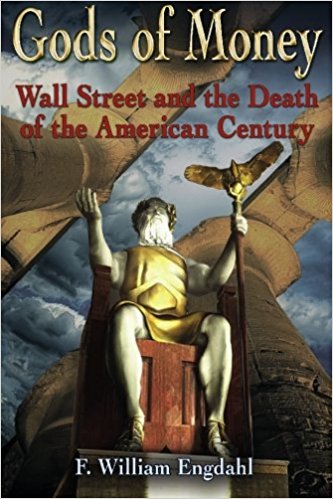
After seeing Muldoon’s interview play on television, Roderick Deane called his bosses, Reserve Bank Governor Spencer Russell and his Deputy Bernie Galvin, who were dining with bankers from the Bankers’ Association at the Le Normandie Restaurant, a quite fittingly symbolic choice of location. The bankers were being very cute because Normandie, or Normandy, to New Zealanders is most famous for the Allied Forces’ Invasion of Normandy in Northern France in June and July 1944. When it is learned that in the inter-war period, the Bank of England’s governor, Montagu Norman, managed the collapse of the Germany economy, in conspiracy with Wall Street and the US Federal Reserve, by masterminding an unstable web of debt, speculation and international trade between 1925 and 1931, the codename for the decisive Battle of Normandy – Operation Overlord – becomes clearer. Indeed, Wall Street Banks deliberately financed the build-up of the Nazi war machine, as numerous authors such as Guido Giacomo Preparata proves in Conjuring Hitler: How Britain and America Made the Third Reich; Charles Higham shows in Trading with the Enemy: The Nazi-American Money Plot 1933-1949, and Anthony Sutton argues compellingly in Wall Street and the Rise of Hitler.[32] The mad purpose of American fascist bankers and industrialists was not only to make a pile of money. The American ‘Fraternity’ aimed to head the world’s dominant military and financial empire, centred on the control of oil. Meanwhile their British counterparts had long ago embarked on a strategy to trigger two-global wars with the intention a conjuring a Hitler to smash the Soviet Empire, whom they feared would form an enduring alliance to dominate the vast Eurasia continent and eventually the world.
With this history, Dean’s secret phone-call diplomacy to the bankers at Le Normandie Restaurant to put his bosses in touch with “certain Ministers” of Muldoon’s cabinet shows that a political-economic coup was in motion.[33] Deane – who remained cagey about who he called in addition to his bosses – joined the conspiracy to mete out Shock Doctrine Therapies on New Zealanders, and instead offered the rationale that the integrity of the institution was more important than full disclosure. This was true only to the extent to protect the conspirators, which by that time included himself.
Dr. Roderick Deane was made a Knight of Realm for excellent services to the Anglo-Dutch-Swiss-Venetian-American Empire.
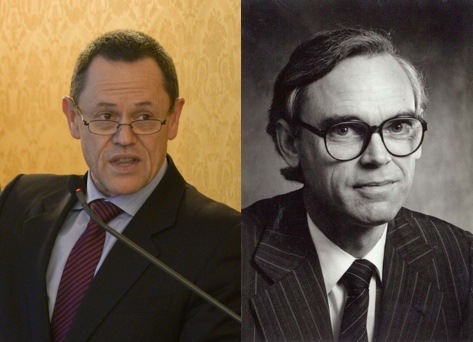
The ‘free market’ sect at the New Zealand Reserve Bank and Treasury ‘stipulated’ to the incoming Labour Government in 1984 that the currency needed to be devalued to resolve a ‘currency crisis’ and high inflation. These measures had be prescribed in a policy position paper imaginatively titled, ‘Economic Management’, which was written by Treasury officials, including Mont Pèlerin Society member, Roger Kerr. Muldoon’s controls over interest rates were lifted. By liberalizing controls over the financial system, the Neo-Colonial ‘Free Market’ Sect opted to favour high capital mobility and stabilize the currency, while scuttling achieving full-employment at a time when unemployment was already over 250,000, out of 3.3 million people. This predicament that nation states face is known as the ‘policy trilemma’. Governments cannot simultaneously pursue the following three broad policy agendas: (1) sustain the wealth that accrues to the workforce; (2) facilitate vast international movements of capital; and (3) manage exchange rate stability, within in a debt-based/tax slave monetary system. At most, only two of these three ‘policies’ can be maintained.[34] Therefore, Roger Douglas’s currency devaluation proposal to the business community prior to the 1984 election was exactly the kind of announcement needed to de-stabilize the currency. When taken together with the thinking behind the reforms – to create a ‘Switzerland of the South Pacific’ that would facilitate fast capital flows for the wealthy, as Douglas himself divulged privately – New Zealand’s ‘free market’ Shock Therapists had made a stealthy decision to wage class warfare. Labour was used as the ‘swing mechanism’ of the ‘policy trilemma’, which meant unemployment levels would be driven higher, thereby adding to a decline in real incomes for the majority of workers as ‘jobs’ became a ‘buyers’ market’ for big businesses to exploit.
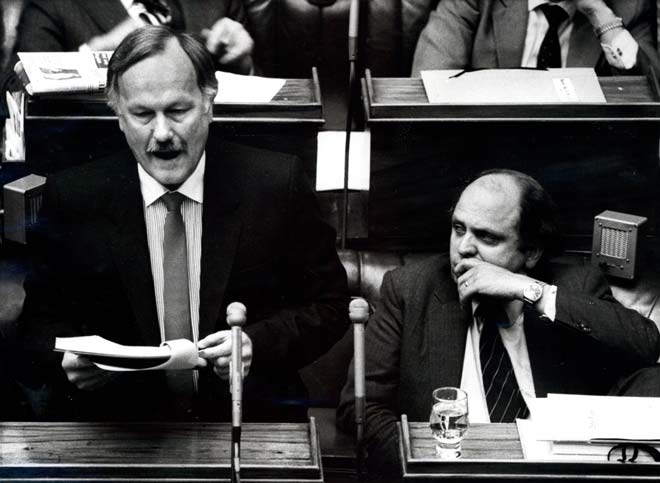
Douglas mentioned the “Economic Management” package in a memo to the Labour Party’s Policy Council Members on the Fraternally symbolic date of 13 February 1984, signaling he was advancing the game.[35] Moreover, Federation of Labour secretary Ken Douglas challenged David Lange and Geoffrey Palmer over the Labour Party’s hidden policy planks that included deregulation and privatization. Lange and Palmer assured Federation of Labour secretary Ken Douglas that the manifesto was not Labour Party’s policy position.[36] Crucially, Roger Douglas was a friend of Roger Kerr’s, who worked in Treasury before moving to the New Zealand Business Roundtable in 1986. [Editor’s note: Ken Douglas was not related to Roger Douglas].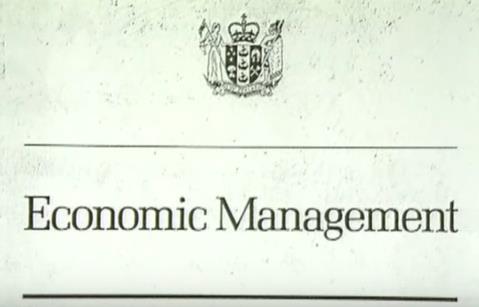
As an under-the-radar member of the right-wing Tasman Institute, which included Rod Deane, Ron Trotter, and John Fernyhough – the new Finance Minister Roger Douglas was credited with choosing the farming sector as the first to face the removal of subsidies, with his 1984 budget. Federated Farmers President Peter Elworthy was able to take some of the heat off Douglas and the government, because he had been strategically lobbying for the removal of farm subsidies.[37] Peter Elworthy, who later became a Knight of the Realm, became a member of the far-right think tank, the New Zealand Centre for Political Studies, which was founded by Shock Therapist Alan Gibbs.[38] This policy shock was particularly hard for farmers, because not only was their sector the first to be reformed after the financial sector was liberalized. The loss of farm subsidies occurred at a time when interest rates were in the high twenties.
Numerous unionists, academics and journalists at the time – and even now – held the belief that there was no malicious intent behind the reforms on the part of the finance ministers, the Business Roundtablers and the policy wonks in the state apparatus. Rather, the flak was limited to criticizing the reformers for their ideological zealousness. For example, Federation of Labour secretary Ken Douglas believed Roger Douglas and and his associate Finance Minister Richard Prebble were ignorant of the role of the Railways, Forest Service, Post Office and Defence Forces as institutional resources to maintain a skills base.[39] Most frequently, this failure to grasp that the callous intent of the ‘free market reforms’ is actually detectable when ‘lefties’ use the word ‘failure’. ‘Lefties’ often use the Voldermort word, Neo-Liberalism, and say it has ‘failed’ or that it is a ‘broken system’.[40] Such statements are a dead give-away that ‘Lefties’ have neither grasped the true purpose of an ideology that was never named, nor why its adherents would universally justify its deployment with the same mantra – the Trickle-Down Effect.
This mantra was universally deployed like a re-worked salvation myth, that stipulated a sacred cow of the old order needed to be sacrificed to save us all from our secular sins. That sacred cow was that the wealthy were still needed for there to be prosperity after an unspecified period of sacrifice. How and why the wealthy had become super-rich oligarchs over the 500 years of the credit revolution that financed empires, was not questioned. But, the faith required for this salvation myth of so-called Trickle-Down economics to gain traction was akin to buying after-life insurance that would deliver eternal market freedom, prosperity for all and efficient solutions to all of life’s problems.
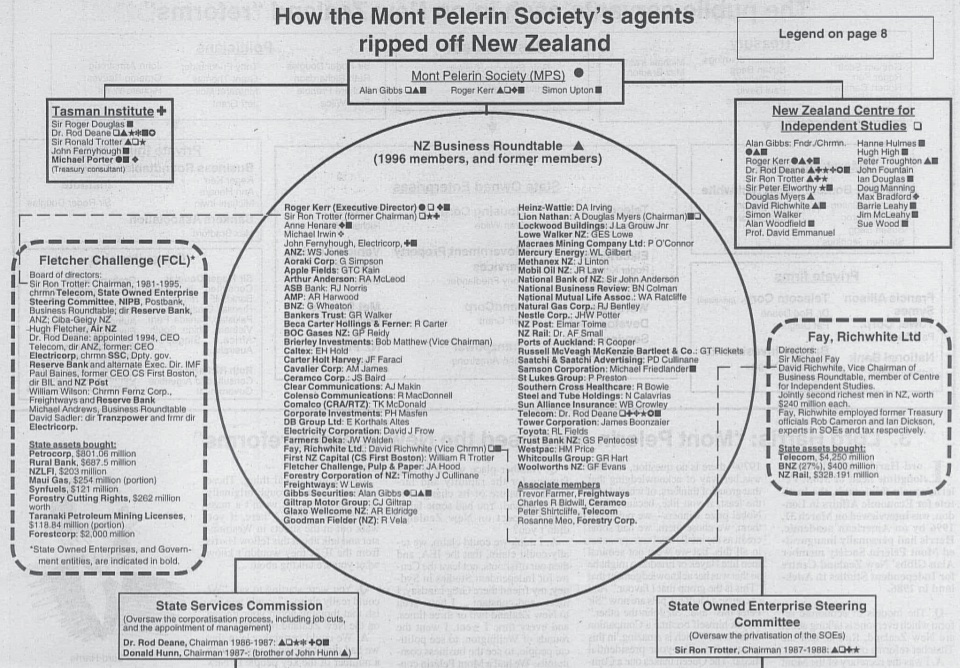 Shock Doctors’ Network: This 1997 ‘New Citizen Report’ by the Australian Citizens Electoral Council found that the Mont Pèlerin Society was the chief economic warfare unit of the British Crown.
Shock Doctors’ Network: This 1997 ‘New Citizen Report’ by the Australian Citizens Electoral Council found that the Mont Pèlerin Society was the chief economic warfare unit of the British Crown.
The maintenance of this view – that ‘Neo-Liberalism has failed’ – tells us that once an ideological framework becomes institutionalized, through technocratic processes, language and the structural forces driving technological transformation, the framework is very hard to unpick.
The view that ‘Neo-Liberalism is broken’ also suggests that the super-rich oligarchs at the top of the Trans-national Capitalist Class, along with their professional class network of elites, actually believe in an ideology they did not bother to name. It assumes that the Trans-national Capitalist Class, and their Professional Class Armies are simply pursuing wealth accumulation because they are addicted to wealth and status and there is no project. This belief, that the inner circles of the Trans-national Capitalist Class actually believe the tenets of Neo-Liberalism, fails to comprehend the obvious contradictions of Crony Capitalism and lets groups of oligarchic-elite criminal actors off-the-hook for their power crimes. The ‘reforms’ were was not simply about greed, or profit autism – but about class warfare or a massive transfer of wealth to accumulate a huge differential of political power – permanently.
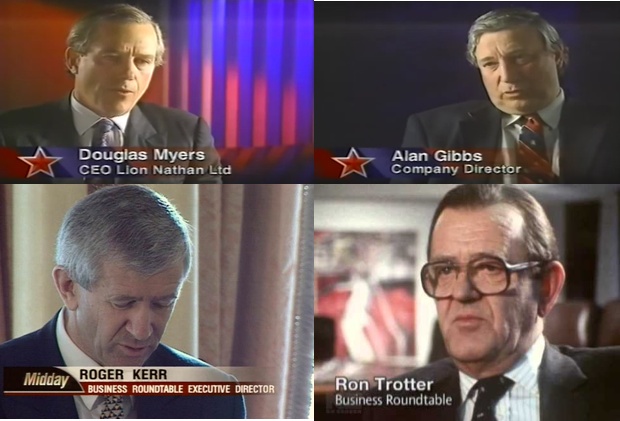 Shock Agents: [L to R] Knights of the Realm Sir Douglas Myers, Sir Alan Gibbs, Sir Roger Kerr and Sir Ronald Trotter were all prominent members of the Mont Pèlerin Society front group, the NZ Business Roundtable.
Shock Agents: [L to R] Knights of the Realm Sir Douglas Myers, Sir Alan Gibbs, Sir Roger Kerr and Sir Ronald Trotter were all prominent members of the Mont Pèlerin Society front group, the NZ Business Roundtable.
Dominant capitalist coalitions are only able to extract high profits through a strategic sabotage of industry, as Jonathan Nitzan and Shimshon Bichler have argued in their book, Capital as Power.[41] This is because large enterprises can only maximize profits by maintaining artificial scarcities. These scarcities are achieved by restricting the creative energies, talents and knowledge of people, or the ‘industry of society’ (which predates capitalism). Such strategic sabotages of industry represent the power of accumulated property rights of investors, to inflict discretionary idleness, as sociologist Thorstein Veblen observed in the early Twentieth Century. Thus, the deployment of ‘free market economic shock treatments’, were a form of economic warfare.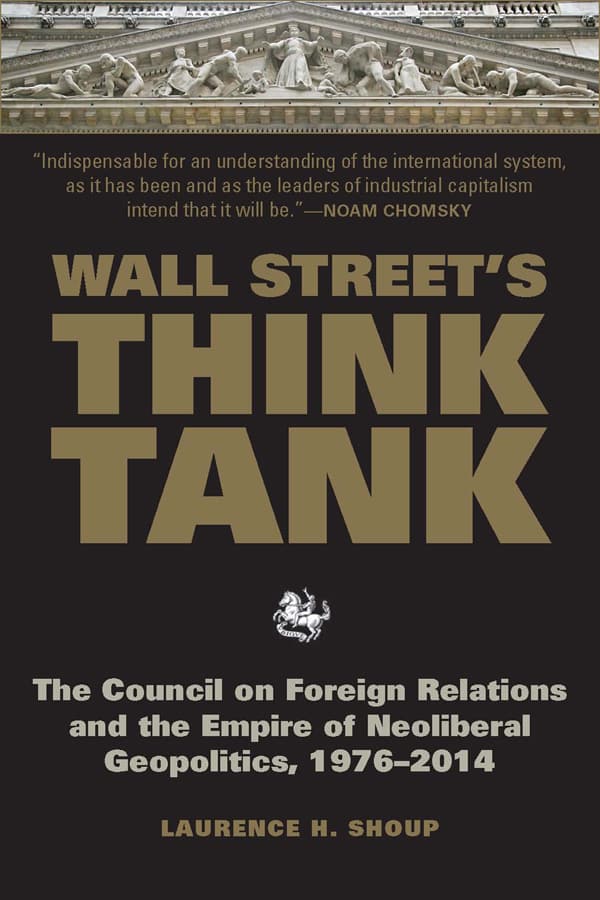
It is pertinent to recall that Tony Molloy QC said to business reporter Brian Fallow of the New Zealand Herald in 1999, “you can often prove criminal intent from people’s actions and the circumstances”.[42] Crucially, conspiracy law developed out of the recognition that groups of people can inflict more harm upon society when they act collectively, as opposed to a person acting alone.[43] A conspiracy is a secret agreement to augment political power to a society’s detriment, whereas collusion involves agreements for economic gain where the intent that underpins them remains hidden. Both conspiracy and collusion can involve explicit and tacit agreements, and can be highly publicized projects. Their defining feature is a hidden malicious purpose. As Neal Katyal found in his scholarly law paper “Conspiracy Theory” published in The Yale Law Journal Neal, once a criminal group has been identified, the threshold of additional evidence that shows enjoinable conduct or a ‘meeting in the minds’ that is useable in courts is lowered.[44] Katyal argued that a “sunk cost trap” dynamic is created when people commit to a specific course of action that binds them and “escalates previous behaviour”.
Thus, the Douglas ‘troika’ comprising Finance Minister Roger Douglas, and his associates David Caygill and Richard Prebble, readied 13 state assets for sale.[45] In the beginning of 1987, Douglas ‘sounded-out’ then-Prime Minister Lange to see if he could push through privatizing hospitals, schools, universities, roads, bridges, and railways.
Lange balked at these proposals, except selling the railways.[46] Lange said,
“I am not in the business of the state owning completely useless, irrelevant, non-state interest enterprises. But I happen to think that we should not have State Highway 1 owned by some division of a Wisconsin, Fay Richwhite consortium.”
Lange considered the railways to be in this expendable category. Between 1987 and 1991, New Zealand Railways sacked 9,000 workers.[47]
Spinelessly, Douglas later downplayed the subversive modus operandi to transfer wealth to his party’s big corporate backers. In a documentary broadcast in 1996, titled Revolution (Part 2): The Grand Illusion, Douglas said he was just throwing around ideas for discussion in regard to Lange balking at the proposition of selling hospitals, schools, universities, roads, and bridges.
The 1987 Sharemarket Crash ended the speculative stocks bubble, drove many companies into bankruptcy and precipitated the collapse of the commercial property boom a year later. Douglas recalled that the 1987 Sharemarket Crash provided him with the opportunity to re-invigorate the ‘free market’ reforms, or policy shocks.
Like his counterparts in the documentary, Revolution: New Zealand from Fortress to Free Market, Douglas’s carefully-chosen words supplied a sanitized account that omitted the plotting of the ultra-far-right thinks such as the New Zealand-based Business Roundtable, the Centre for Independent Studies, and the Tasman Institute, and an international coterie of think-tanks, including: the Council on Foreign Relations, the Trilateral Commission, the International Democratic Union, the Institute of Economic Affairs in London; the Hoover Institution at Stanford, the Cato Institute, the Heritage Foundation, and the American Enterprise Institute, and the pan-Atlantic Bilderberg Group. A core principle that underpinned the modus operandi of this international oligarchic-élite think tankerati was regulatory capture, by which was meant that the front-men of politics serve an invisible hand of “special interests” as Milton Friedman bragged in a speech marking the 200th Anniversary of British East India Company operative Adam Smith’s 1776 book, The Wealth of Nations.
As Chris Lehmann observed in his article “Neoliberalism, the Revolution in Reverse”, the ‘neoliberals performed a neat trick” by promoting regulatory capture because they, in effect, positioned “corruption as a permanent condition of the regulatory state” to a small cohort. Indeed, a colleague of Milton Friedman’s at the University of Chicago, George Stigler, dismissed moves to confront regulatory agencies that had become hostage to industries they were supposed to regulate in an insipidly titled 1971 journal article, “The Theory of Economic Regulation.” Stigler likened corruption reformers complaints to criticizing “the Great Atlantic and Pacific Tea Company for selling groceries”. Lehmann pointed out that Friedman was the chief propagandist who promoted ‘free markets’ rather differently through the public media, specifically as an abstract market guided by ‘invisible hand’ that was explained away as the combined activity of buyers and sellers serving their own self-interest throughout an economy, producing the aggregated result of serving society’s progress in a state of continuous prosperity. Thus, an asymmetric information system was constructed and refined, wherein think-tanks acted as conduits for tiered levels of knowledge. Key insiders were privy to the malicious intentions of the ‘free market’ shock therapies, while decent folk in the state and corporate bureaucracies were targeted for brain-washing with the ideological rhetoric of the mis-named construct: Neo-Liberalism.
In this devious way, crisis actors who can control the ritualized symbolic actions in the midst of a crisis can constrain its meanings and gain from the calamity, as crisis expert Paul ’t Hart argued more generally in the Journal of Contingencies and Crisis Management in 1993.[48] Indeed, I have found that crisis actors encode events with the number thirteen. As we shall see, the curious recurrence of ‘Thirteen’ is disturbing. Thirteen has an occult significance among a ‘Fraternity’, for whom it signals ‘unity and love’. Encoding events with 13 signifies that key players are advancing ‘the game’.
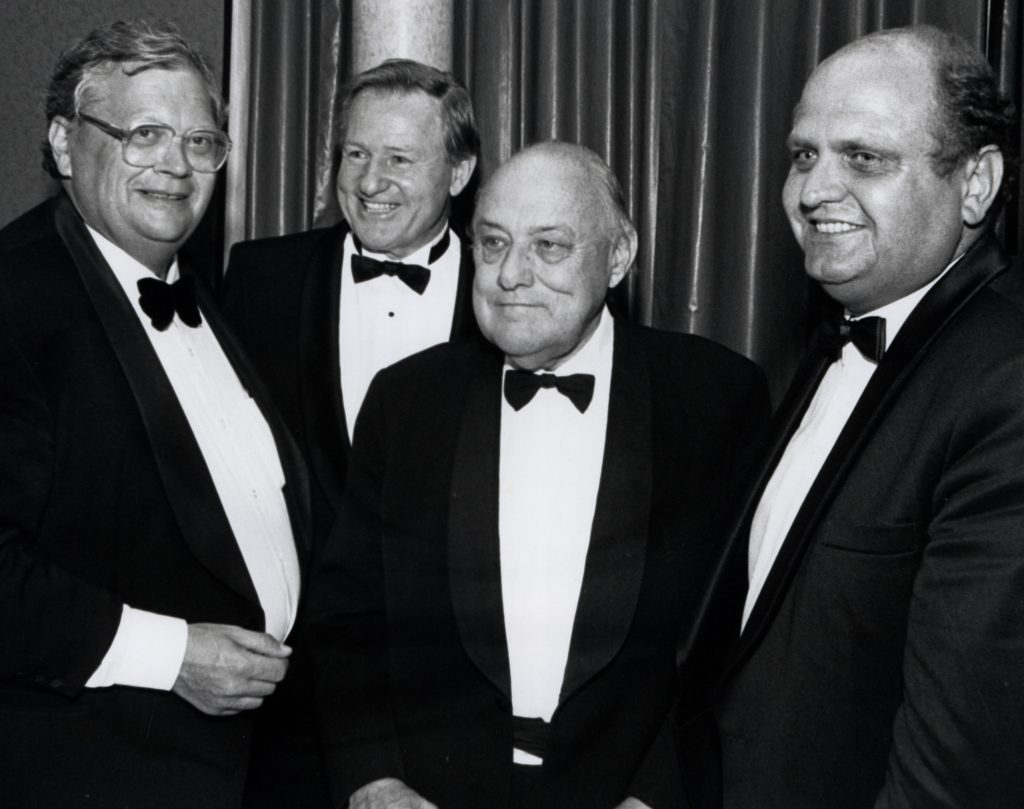
Such asset sales were predicated on a corporatization of state trading entities, infrastructure and services, mass lay-offs of public sector workers, a stealthy form of flat personal tax on most goods and services (GST), the introduction of ‘user pays’ fees, exorbitant private sector monopoly prices and widespread compliance fines. All the while, a Roman-esque universal income tax collection system was maintained and backed by state coercion to fund infrastructure projects, corporate welfare bailouts and ‘national debt’ servicing of foreign privately-manufactured credit.[52] By December 1996, firms linked to the Business Roundtable accumulated $12.542 billion of the $15.322 billion privatized assets, including Fletcher Challenge, which bought one-fifth.
The state asset sales were designed to transfer wealth to Rich-Listers, enable extortionist pricing business models, and concentrate power. Rural and provincial communities were thrown into crisis because farm subsidies were suddenly removed first, hospitals and post offices were closed and state-owned enterprises were corporatized. Between 1987 and 1995, tens of thousands of people lost their jobs. In the private sector, manufacturing employment dropped by 30%, while in the public sector, 62,100 people were sacked by the state.[53]
Ironically, David Lange himself said in the 1996 documentary, Revolution, that his vision for the second term of his government was to make the state:
“the warrantor of opportunity. Not of equality. I wanted the state to give people the chance to become unequal and to have their abilities tested to the limit by whatever they were disposed to do.”[54]

Sweet Nothings: Lange promised social justice issues, employment, health and education were core Labour policy platforms, but neglected to say that democracy is a ‘voted dictatorship’ – as he later said live on Triangle TV during a 1998 Auckland mayoral race.
In Revolution: The New Country, Sir Roger Douglas also claimed “we dismantled privilege”.
All the while, Douglas had deployed Shock Doctrine policies that exploited crises, knowing that he was creating a ‘Switzerland of the South Pacific’ where a top strata of wealthy families would make New Zealand an unaffordable place to live for most. Therefore, Douglas presented a fraudulent gloss in breach of section 240 of the 1961 Crimes Act, which deals with deceptions, in his interview for the television documentary series, Revolution, and also prior to and during his reign as finance minister. Douglas’ deceptions were well known to key insiders, who advanced the Shock Doctrine framework after he resigned from his finance minister portfolio in 1988.
Indeed, at a Mont Pèlerin Society conference in Christchurch in 1989, Mont Pèlerin Puppet Actor Roger Douglas bragged of his shock therapy modus operandi to overwhelm multiple sectors to the 400 attendees.[55] As Jane Kelsey notes in her 2015 book, The Fire Economy, Douglas published this articulation of his ‘blitzkrieg strategy’ in ‘Chapter 10: The Art of the Possible’ of his 1993 book, Unfinished Business. Douglas’s book was published as his manifesto for the ACT Party, which was largely bankrolled by corporate raider, Sir Alan Gibbs, ahead of the first MMP election in 1996.
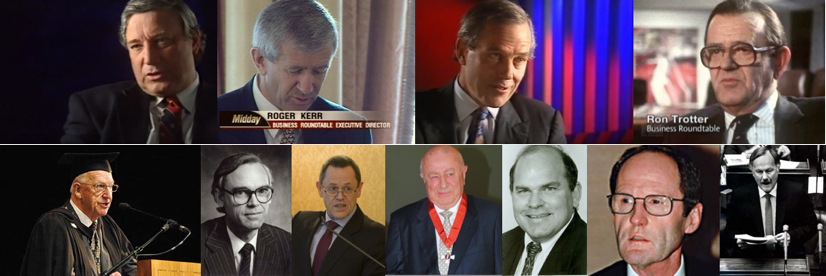
“It was like a re-run of 1984 with different actors.”[56]
The new Finance Minister Ruth Richardson wasted no time attacking the sacred cows that Labour Cola would not kill – welfare reform and employment contracts.
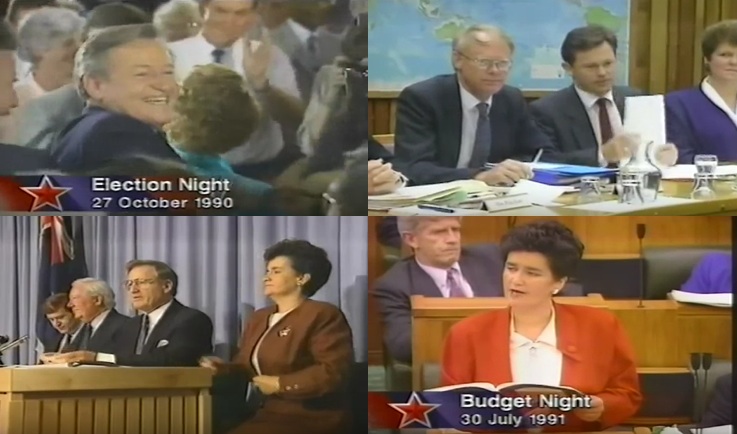
In 1991, the unemployment benefit was cut from $144 to $130 a week; $130 – as a multiple of 13 signifies Fraternal ‘unity’. In 1993, National Government passed the Employment Contracts Act, which ended union control over workplaces and was designed to bring down wages, which it did.[57]
In their second term, and just prior to the 1999 election when the smart money knew the Shipley Ministry would lose power,[58] Pepsi National removed house price inflation from the Consumer Price Index (CPI),[59] which is the key economic measure of rising costs of living, or inflation. Because the CPI does not factor in the interest component as the key driver of rising house prices over time, the impact of each generation seeking to re-sell at a level above the inflation-adjusted purchase price plus the interest – is lost in this stripped-out measure.
In his summing up words for the 1996 documentary series Revolution: The New Country, the former Lange-Labour Government Minister of Finance and leader of the newly-founded ACT Party, Mont Pèlerin Puppet Actor Sir Roger Douglas, said:
“In politics, it’s the ‘Art of the Possible. If you’ve got an opportunity and you want to undertake reform, do it.”
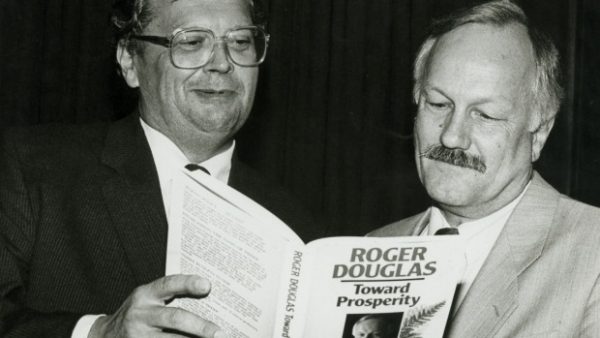
Douglas was made a Knight of Realm for excellent services to the Anglo-Dutch-Swiss-Venetian-American Empire.
Neo-Colonialism: The Last Stage of Imperialism
The legacy of the Shock Doctrine economic warfare framework outlined here is that New Zealand is a mangled trauma-inflicted society beset with multiple crises. By the beginning of 2017, when The Economist reported New Zealand was ranked as the most unaffordable place to live in the world, NZ’s total debt also topped half a trillion dollars.[60]
The vision of a ‘Switzerland of the South Pacific’ was about creating an unequal society that required smashing the value of egalitarianism, countering the renaissance of indigenous Māori – who were down to 3.74 million acres out of New Zealand’s 66.4 million acres in 1996 – and about forging a super-rich plutocracy where billionaires would pay premium prices for boltholes in a wealth-secrecy haven with a double-life as the world’s premiere Tax Farm Smart Grid Test Lab – regardless of whether it was Labour Cola or Pepsi National in power.
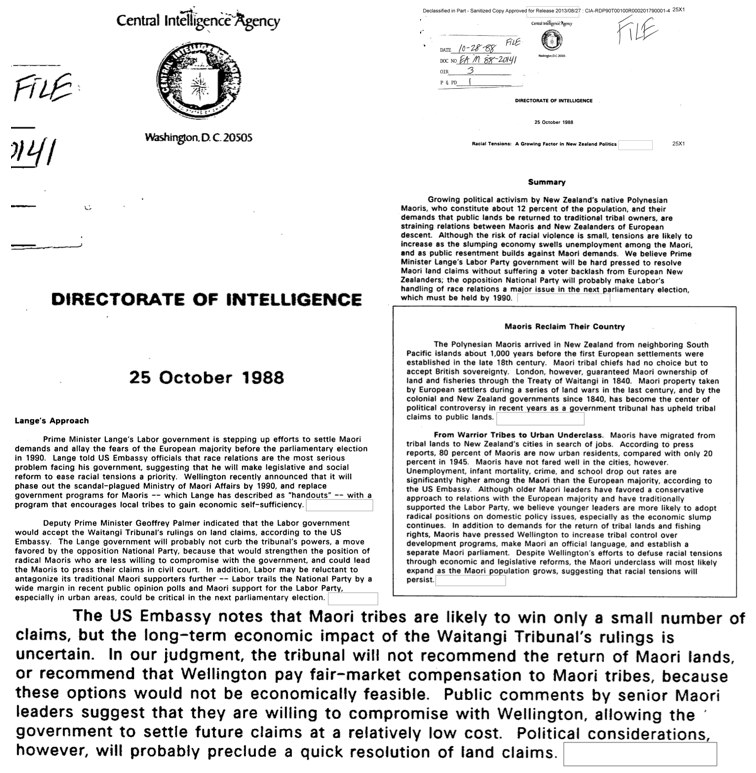
Indeed, an unsanitized CIA report from 1988 titled, “Racial Tensions: A Growing Factor in New Zealand Politics”, offers a revealing insight into the mind of a thugful intelligence agency known to have been behind numerous coups against governments and populations that resisted the will of US-based transnational corporations.[61] The CIA report stated that the Waitangi Tribunal was not likely to recommend to return of lands, or a fair-market value because numerous Māori leaders had indicated that they did not expect it to be a feasible proposition economically or politically.
As Mont Pèlerin Society member and National Party MP Simon Upton told the New Zealand Herald in 1989,
“New Zealand is well situated to be a supplier of raw materials to richer neighbours, a home to well fed peasants who hopefully would not unsettle things for the outward looking elites.”[62]
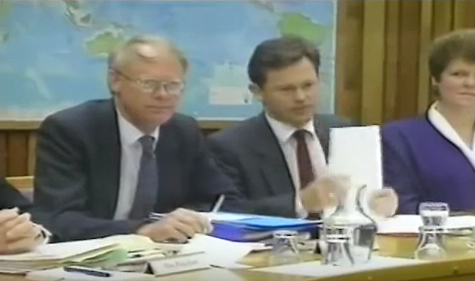
Mont Pèlerin Agent Saboteur Simon Upton, who later became Bolger’s Health Minister, was one of only three New Zealand Mont Pèlerin Society members. The other two Mont Pèlerin Agent Saboteurs were: then-ForestCorp and Electricorp chairman, and founder of the Centre for Independent Studies, Sir Alan Gibbs; and former Treasury official, Electricorp Director and NZ Business Roundtable Executive Director Sir Roger Kerr.
In their 1997 The New Citizen Report,[63] the Australian Citizens Electoral Council found that the Mont Pèlerin Society was the chief economic warfare unit of the British Crown, and was responsible for planning the “looting and the destruction of the nation-state of New Zealand.” The Society had three New Zealand front groups, foremost the Business Roundtable. Merchant bank CS First Boston’s First NZ Capital produced ‘free market’ reports and lured four Treasury officials, including now-billionaire Stephen Jennings.[64]
The impetus for this re-set of the New Zealand Realm and the rest of the world came from the then-North Atlantic Capitalist Class, who faced several major crises. These were a structural crisis of Declining Profit Rates, the numerous peoples’ movements of the 1960s and demands from a Developmentalist Movement in ‘Third’ and ‘Second World’ countries for Western technologies in fair return for the resources they had supplied for the rebuild of Western Europe and Japan following WWII.
To counter these crises, the North Atlantic Capitalist Class developed a ‘free market’ economic warfare framework to transform the world, as Requiem for an American Dream shows.[65] This ‘imperial brain trust’ blueprint – dubbed the ‘1980s Project’ – was first formulated between 1971-1973 at a New York-based think-tank, the Council on Foreign Relations.[66] Key insiders at the Council on Foreign Relations planned the spread of ‘free markets’ by exploiting Milton Friedman’s modus operandi of ‘speed, suddenness and scope’, which were field-tested on Brazil, Indonesia, Chile, Uruguay and Argentina using military violence to destroy the Developmentalist Movement.[67] Strategic sabotage of industries ensued.[68]
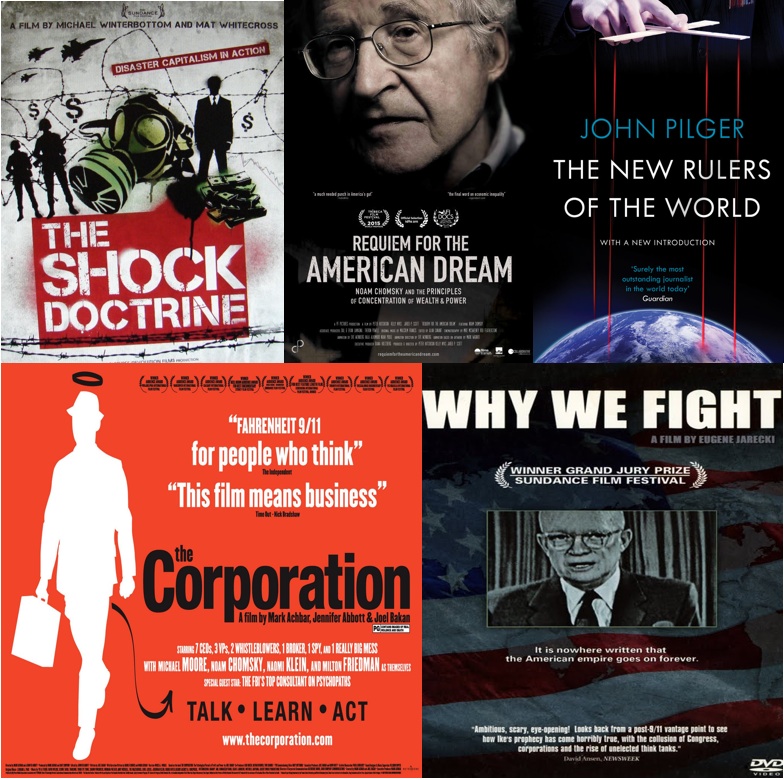
As you might expect from a Deep State criminal group dubbed the ‘imperial brain trust’, a world debt crisis was set in train to coerce governments to submit to their ‘1980s Project’.
A Rockefeller-Kissinger-Bilderberger Nexus of conspirators orchestrated the 1970s Oil Price Crisis by plotting the Yom Kippur War of 1973. The plot of Kissinger & Friends was to establish a new “world price for oil”, to re-invigorate the privately-owned US Federal Reserve’s military-backed Petro-Dollar cartel, and to create a world economic crisis with huge ‘borrowings’ to coerce governments to submit to the coming ‘free market’ paradigm: Neo-Colonialism.[69]
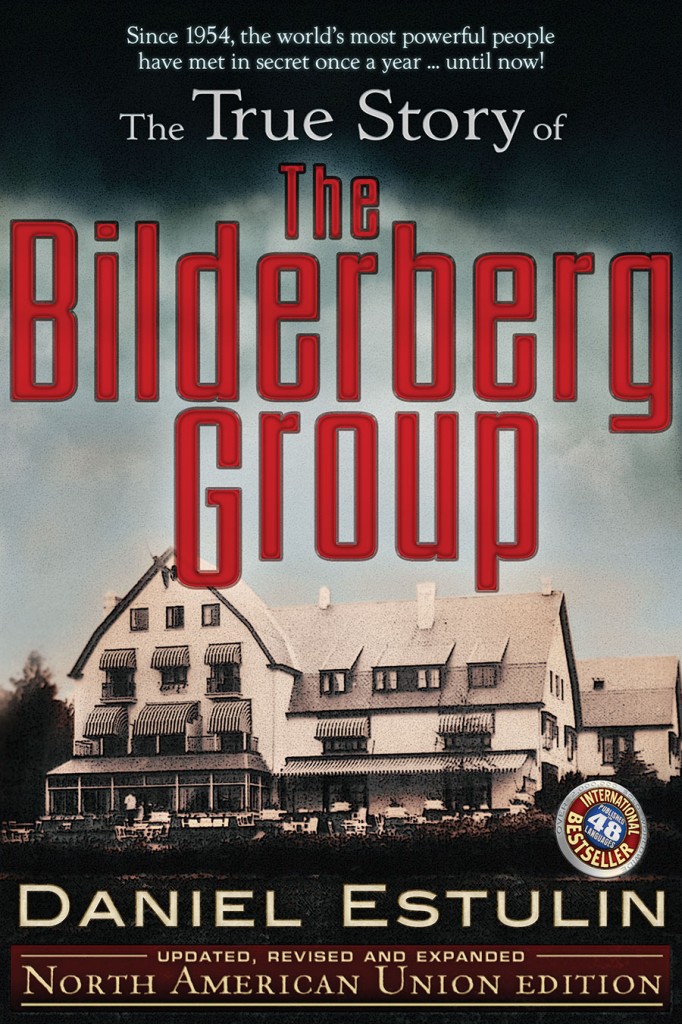
To this end, a May 1973 secretive Bilderberg Group meeting on the island resort of Saltsjöbaden, owned by the Swedish Wallenberg banking dynasty, plotted how to exploit the oil price shocks as a result of Kissinger’s scheme to deceive the Egyptians, Syrians and Israeli’s about each other’s agendas.[70] The 1973 Oil Price Shock returned enormous profits for key conspiring banks and the oil majors, including Rockefeller’s Chase Manhattan Bank and the monopolistic Standard Oil cartel (now Exxon Mobil). Amid rapidly rising oil prices, exports plummeted as families’, businesses’, governments’ purchasing power dropped, production costs for all countries soared, and states borrowed from the IMF because tax revenues fell as exporters’ sales dropped and whole economies stagnated. This is how and why an epic debt bubble blew in 1982 and was known the ‘World Debt Crisis’. In this political conspiracy to mete out economic warfare – first through the intrigue of a small war, then an economic crisis that a world financial crisis – another think-tank, the Trilateral Commission,[71] was tasked to formulate policies, strategies and tactics to further what the Bilderberg Group-mouthpiece, The Economist magazine later called a “counterrevolution”.[72]
The Neo-Colonial Sect developed their Shock Doctrine modus operandi to undermine nation state autonomy.[73]
In his 1965 book Neo-Colonialism: The Last Stage of Imperialism – former President of Ghana, Kwame Nkrumah, wrote a Neo-Colonial state has the outward appearance of international sovereignty, but because its economic resources and financial systems are controlled from outside, the political apparatus takes external directives.[74] Nkrumah showed the former European colonies of Africa found their hard won political independence was literally undermined by highly interlocked mining, oil and banking consortiums that controlled indigenous economic resources and ran national financial systems. “Neo-colonialism, like colonialism, is an attempt to export the social conflicts of capitalist countries”, wrote Nkrumah, “[and] increases the rivalry between the great powers”. Once a country is captured by Neo-Colonialists, a dynamic is set in motion that compels neighbouring countries to adopt the Neo-Colonial framework.
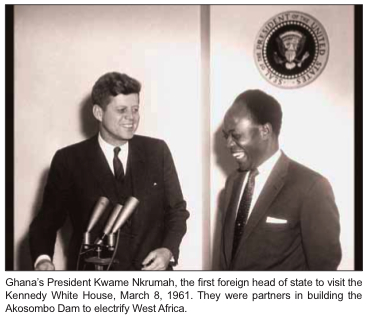 Developmentalist Leaders: Both presidents were pro-development, as historian Anthony Chaitkin explores in a video interview, “JFK vs Empire”.
Developmentalist Leaders: Both presidents were pro-development, as historian Anthony Chaitkin explores in a video interview, “JFK vs Empire”.
Indeed, in The Politics of Money, it is argued that capitalism, as a political-economic system, has incrementally severed communities from their “customary rights of access to the means of life.” This is hardly news to indigenous peoples of the ‘New World’ who bore the brunt of 500 horrific years of European expansionism fueled by the credit revolution.
So, why did the key conspirators who orchestrated a Neo-Colonial corporate takeover of a land once named on maps as ‘Maoriland’ expect that ‘in 25 years time, most New Zealanders would not be able to afford to live here’?
Here’s where the secrets of how banks conjure credit and why bankers are zombies feeding off the hapless host population – gets explained.
The common understanding is that banks simply loan out the deposits of other savers. However, banks use most of the money they receive to buy interest-bearing treasury securities, corporate bonds and other financial instruments.[75]
The dirty secret of banking is that bank ‘loans’ are actually manufactured credit.[76] Through their structural alignments, the world’s largely unseen dynastic bankers ensure that actual cash is scarce. This scarcity compels families and businesses and governments to ‘borrow’ the bankers manufactured credit to build a home, an enterprise or a hospital, respectively, and compete to ‘repay’ the privately conjured credit.[77]
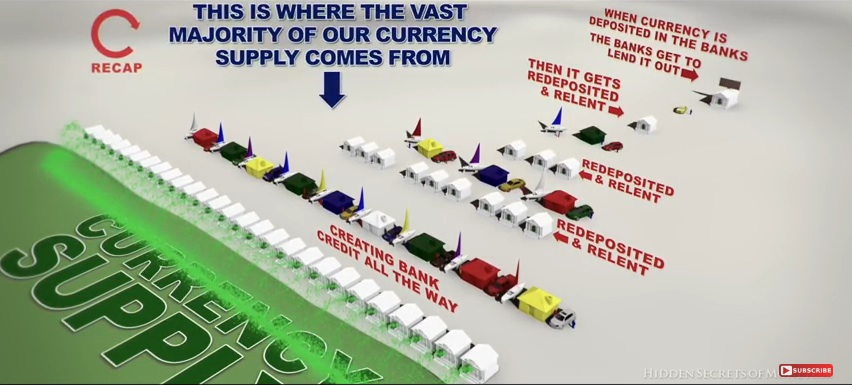
Biggest Scam: 92-96% of currency is created as commercial bank credit. [The Biggest Scam in the History of Mankind].
When a new ‘loan’ is made, the manufactured credit is deposited into the chequing account of the ‘borrower’. Each time the proceeds from the sale of property are re-deposited, the banks have new funds that add to the deposit base to make new ‘loans’. In other words, banks need only hold reserves that equate to a fraction of the actual deposit claims on their books, in a fractional reserve banking system. In addition to earning profits off income-generating financial instruments, banks build up reserves by using some of the proceeds from the interest they charge for ‘loans’.[78] In this way, interest is not “the price of money” – since no money that previously existed is lent. Rather, interest represents a rent on the amount of funds ‘loaned’.[79]
Therefore, each generation are cast as borrowers who are compelled to sell their homes and businesses at ever higher values just to break even because of the ‘rent’ banks charge for their manufactured credit, as English economist Michael Rowbotham stated in his book, The Grip of Death: A Study of Modern Money, Debt Slavery and Destructive Economics. Despite central banks’ ability to manufacture and obliterate “unlimited supplies of money and credit,” as former chairman of the privately-owned Federal Reserve consortium Alan Greenspan put it,[80] most credit is created by commercial banks through this ‘multiplier effect’ of ballooning credit bubbles, as Mike Maloney states in his documentary series, The Biggest Scam in the History of Mankind. Therefore, debt-based currency systems ‘stabilize’ the present and future for the ruling banking cliques, since the time of the Global Tax Herds is wasted working witlessly to build-out the Global Tax Farms’ new hi-tech ‘fencing systems’. Since Crony Capitalism’s hidden purpose is to make land scarce to as many Tax Cattle as possible,[81] dismantling the debt-based currencies, mass land redistribution and interest-free positive money economies are necessary for the emancipation of the human species.[82]
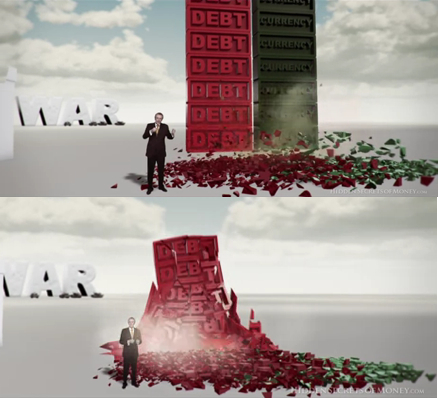 Mutually Assured Destruction: If all scarce currency were used to ‘repay’ credit ‘loaned’ simultaneously, the global debt bubble would be destroyed.
Mutually Assured Destruction: If all scarce currency were used to ‘repay’ credit ‘loaned’ simultaneously, the global debt bubble would be destroyed.
The result is that there is a deep structural crisis for Neo-Colonial Capitalism in New Zealand. The South Pacific Realm is an asymmetric economy of highly uneven wealth distribution, political power and class privilege. Meanwhile an infrastructure crisis in the agglomerated city-machine, Auckland, distracts everyone from thinking about the root causes. The Rich-Listers’ avarice has embroiled Auckland City in a ‘Global Cities Movement’ project, wherein such world-cities are serviced by public debt-funded infrastructure, Neo-Colonial institutions favouring high capital mobility, and large pools of excess labour to support the huge geographically dispersed transnational corporations that seek to accumulate capital faster and faster.[83]
In a Neo-Colonial Capitalist system, structural pressures are intensified to construct huge cities – where high capital mobility and systemic unemployment are in-built. Such structural pressures serve the aggressive logic of yield-seeking capital that drives wealth accumulators to keep zombie capital ‘alive’ with new growth opportunities. Consequently, New Zealand is a crisis-ridden society beset with a ‘Shock Doctrine’ economic warfare framework.[84]
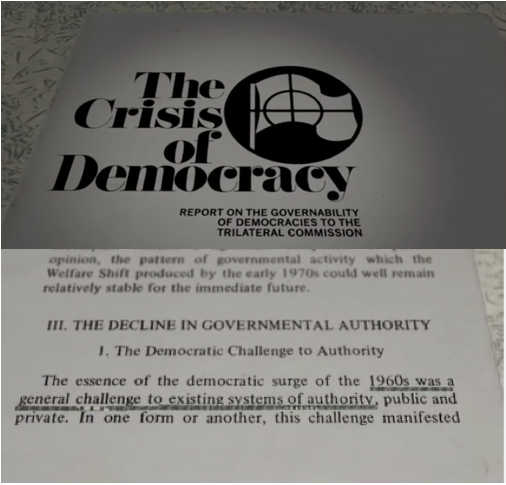
The NZ Tax Farm Lab’s amplified wealth gap permits the ongoing presence of Rich Lister Civil Oligarchy, who – by their nature – thrive amid crisis-ridden societies. These shock treatments discriminate against New Zealand’s most vulnerable – 300,000 children, or one third, who live in poverty.
The Lange Labour and the Bolger National ministries pursued the secret state policy to keep the level of people out of work at a level of around 6% of the labour force.[85] Because huge pools of unemployed people create the visible spectacle of poverty, it works as a coercive mechanism to keep wages and salaries low for big businesses investors, as experts recruited in Alister Barry’s documentary, In a Land of Plenty, such as former Reserve Bank director Suzanne Snively (1985-1992), argued compellingly.[86]
This structural unemployment policy, which was meted out by the Reserve Bank-Treasury-Business Roundtable-Labour-National Government-Neo-Colonial Crown Nexus in the 1980s and 1990s, was established through mass public and private job destruction. The Reserve Bank’s inflation-targeting policy, which works through setting the interest rate for central bank-treasury credit, is a key policy component for maintaining structural unemployment. The overt purpose of controlling interest rates is to stimulate or cool ‘lending’ relative to economic activity so that inflation stays within an agreed target of 1 to 3%. The covert purpose is to manage a Shock Doctrine policy that I call asymmetric inflation, which encourages asset price inflation by supplying cheap credit to fund house flipping, a landlord vulture culture and capitalist class cohesion. Meanwhile, pro-corporate groups lobby to keep wages and salaries suppressed. Therefore, the inflation-targeting policy works in tandem with structural unemployment as a coercive blackballing shock policy that ostracizes working class people socially from the human need to have security over their own shelter. By placing more control over housing, employment, and business ownership into the hands of the capitalist class, which is dominated by an out-of-control Neo-Colonial Sect, the New Zealand Crown is deliberately facilitating an economic warfare paradigm.
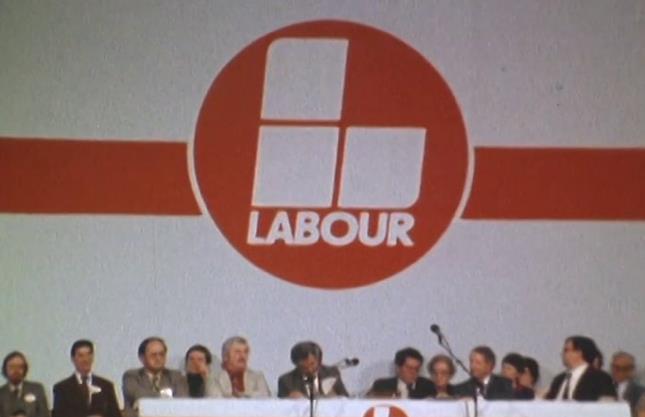
By aiming to keep inflation at between 1% and 3% per annum, the Reserve Bank has maintained cheap manufactured credit supplies through private international credit lines on the proviso that New Zealand’s business and banking elites advance the game together of keeping wage and salaries suppressed, thereby ensuring that economic prosperity is asymmetric, or one-sided.
Together, these ‘market fundamentals’ help the Reserve Bank achieve their 1-3% cost inflation target that, in turn, supplies wealthy investors. Access to cheap credit means the rich and super-rich are free to pursue maximum asset wealth ‘creation’ in an economic environment characterized by asymmetric inflation, where the ‘flattened’ costs for labour are most starkly contrasted with high prices for essentials such as food, power, fuel and housing. Because all industries are dominated by a small handful of New Zealand Rich-Lister-owned franchises, or foreign-quartered transnational consortiums, such cartelized markets are free to set high prices that earn investors exorbitant profits. The extraction of exorbitant profits over and above production costs and modest returns for investment, actually represent extortion fees for not withdrawing supply. With cheap credit as a reward keeping cost-side inflation of wages and salaries suppressed, the ‘property rights’ of the rich – which are code for asset wealth – are enhanced. An asymmetric economy requires binary systems such as privileged wealth accumulation/mass wealth confiscation, that is comprised of a wealth haven complex for the rich and a universal Roman-esque tax system for the captive Tax Cattle.
Former governor of the Reserve Bank of New Zealand between 1988 and 2002 – Don Brash – presided over the transfer of monetary policy decision-making power from the government to the New Zealand Reserve Bank. This transfer of power included achieving inflation targets, which underpin the state’s hidden Shock Doctrine policy of structural unemployment.
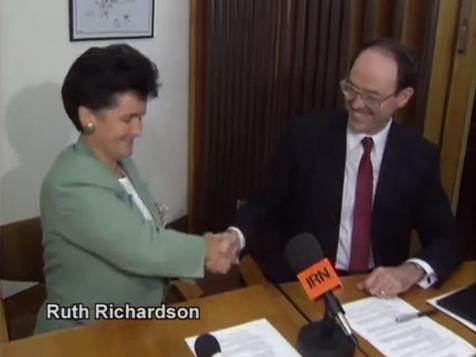
To inflict job destruction in the state sector in the mid-to-late 1980s, through corporatization and then privatization of state infrastructure and services into the early 1990s, key insiders of the New Zealand state apparatus had made a secret pact with big business to wage economic war on society, as I have outlined. These shock treatments were designed to accumulate more power for the wealthy through accelerated extraction of capital, or profits, as Wellington filmmaker Alister Barry has shown in his documentaries, Someone Else’s Country: The Story of the New Right Revolution in New Zealand and In a Land of Plenty: The Story of Unemployment in New Zealand.[87]
Although New Zealand is ranked the most unaffordable place to live in the world relative to incoming funds, the strategic sabotage meted out by the Shock Therapists has not shoved New Zealanders out of New Zealand to the extent that Sir Roger Douglas and his accomplices had intended. Their vision of a ‘Switzerland of the South Pacific’ through the Shock Doctrine economic warfare framework was partially arrested by New Zealanders resisting the onslaught. The strongest resistance came from ‘the natives’. The Māori Renaissance that emerged in the late 1960s turned out to be the thing that saved New Zealanders being almost totally emptied of New Zealanders, including Māori.
Because political conspiracy and collusion by elite criminal groups are poorly understood, complex and difficult to confront – academics, law enforcers and reporters all tend to fail to nail them. For instance, in his paper, “Policy Conspiracies and Economic Reform Programs in Advanced Industrial Democracies: The Case of New Zealand,” Joseph L. Wallis, found there was political conspiracy to deploy ‘free market reforms’. But, Wallis woefully failed to theorize for conspiracy. His assumption that key players were ‘benign’, left his detective lens too grimy to see their secret intentions, methods and network as circumstantial evidence of malicious power crimes. As Anthony Chaitkin explained in his book Treason in America about the epic subversion the republic of the United States of America, a multi-generational grand conspiracy requires a powerful ideological motive. The buying-out of New Zealand accomplices was achieved with the lure of the utopian vision to forge a ‘Switzerland of the South Pacific’. Because this vision was heretical to most New Zealanders’ ideal of a society – which was an Egalitarian Utopia – the ‘Switzerland of the South Pacific’ vision had to be achieved by stealth, with Milton Friedman’s ‘speed, suddenness and scope’ modus operandi working in the favour of special interests – the real ‘invisible hand’ of the fake ‘free market’. Therefore, New Zealand’s utility to the world would simultaneously be a premiere test facility, with New Zealanders cast as compliant test subjects living in culturally-diverse diaspora, and a bolt-hole for billionaires.
Further research is needed to flesh out the silent revolution outlined here. Nicholas Hagger’s study – The Secret History of the West – that covers a 550-year period of revolutionary movements shows the patterns behind the conspiratorial dynamic. Hagger shows that for a revolutionary movement to succeed someone or some group needs to articulate an heretical occult vision, someone plays the role of the heretical occult interpreter, then along comes an occult revolutionary originator, thoughtful intellectual interpreters that provide the intellectual expression, and political actors that provide the political expression and follow through with the physical consolidation. Any conspiratorial enterprise requires funds and the money is always used to advance the Utopian vision through deepening the control of institutions, resources, technologies and systems. This leads to a deeper research question: how exactly and why exactly was the New Zealand economy taken over, and by whom exactly? A conspiracy theory document titled “The Opal File”, which purports to be a secret history of Australia and New Zealand from 1967-1987, offers an intriguing launching point for further inquiry. Whoever wrote “The Opal File”, which was widely circulated on university campuses in the late 1980s knew the territory of the subject. It outlines the hand of the Trilateral Commission, mentions the CIA drug money laundering Nugan Hand Bank operation used by the ‘Mr Asia’ drug ring, the little known fact that Muldoon was appointed chairman of the board of the World Bank and IMF in 1979, and specifies the alleged secret bank accounts claimed to have been set up for Robert Muldoon, David Lange, Roger Douglas and Jim Bolger to receive CIA bribes. As the authors of Dope, Inc. – Britain’s Opium War Against the World observe, the British oligarchy has long used drug trafficking as a means to addict the élite of countries targeted for takeover, because it weakens social defenses, overwhelms the apparatus with crises and greases the wheels of empire with a competitive advantage to buy assets.
Regardless of whether or not the ‘The Opal File’ is accurate, I have shown there was a political conspiracy to takeover the New Zealand economy, impoverish whole groups of New Zealanders and set a trajectory where the country would become an increasingly unaffordable place for most New Zealanders to live. Even if readers do not take my account that Roger Douglas bragged in late 1986 about the purpose of the ‘free market’ reforms as true, the rest of what I have outlined is verifiable by the public sources I have cited. Furthermore, I have provided a unique account of the how, the why and the who, a new critical interpretation of the impacts of the economic Shock treatments and a robust theoretical framework to sharpen the research. Even so, I still feel like I have barely scratched the surface of the intrigues that went down.
This political conspiracy has impoverished hundreds of thousands of New Zealand’s most vulnerable families, and is one of the main structural causes of systemic child poverty.[88] It should be clear to both conservative and liberal readers that New Zealand got mangled in the 1980s and 1990s and that the reforms occurred not out of some altruistic ideological belief that everyone would eventually prosper after an unspecified period of pain. The ideological construct now called Neo-Liberalism was a cover-story for an economic warfare framework, with an in-built hidden Shock Doctrine script, the involved the strategic sabotage of industry, the transfer of wealth upward and the construction of wealth secrecy havens. Because New Zealand was a hollow society prior to the political-economic-bureaucratic coup of 1984 – with a dominant Pākehā population un-rooted to the country’s history, living by an egalitarian myth, and submissive to conformist institutions – this South Pacific Realm was an ideal test lab for a take-over by the Deep State Shock Therapists.
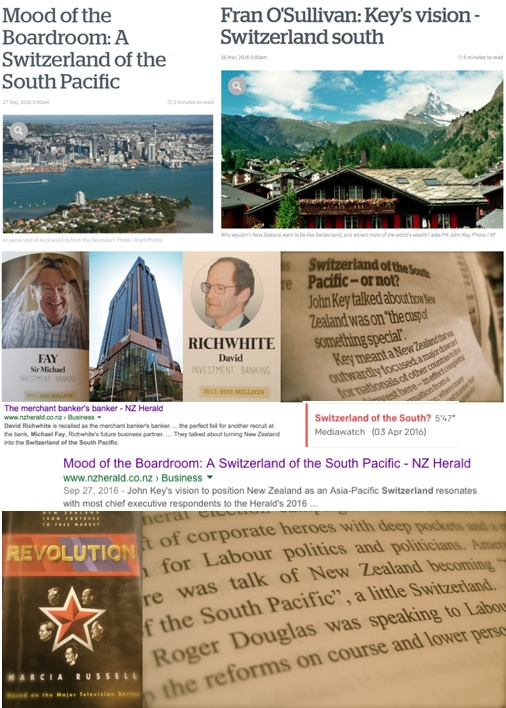 Reflecting a Switzerland of the South Pacific Vision? Merchant bankers Michael Fay and David Richwhite talked in the mid-1980s of transforming NZ into a Switzerland of the South Pacific, or a foreign exchange capital. Roger Douglas bragged in a private conversation in 1986 that there would be a top strata of wealthy and in 25 years most New Zealanders would not be able to afford to live in NZ.
Reflecting a Switzerland of the South Pacific Vision? Merchant bankers Michael Fay and David Richwhite talked in the mid-1980s of transforming NZ into a Switzerland of the South Pacific, or a foreign exchange capital. Roger Douglas bragged in a private conversation in 1986 that there would be a top strata of wealthy and in 25 years most New Zealanders would not be able to afford to live in NZ.
The current economic wreckage is evident in 42,000 homeless people, or one in a 100,[89] 606 annual suicides in the last year,[90] and 132,000 unemployed[91] (if the government’s cooked figures are to be naively believed, since just one hour of work a week counts as employment).[92]
The structural attacks on the poor, as well working class and so-called middle class people, are designed to prevent challenges to the Neo-Colonial Civil Oligarchy’s outsized wealth. [93] By weakening the capacity of the mass populace from participating in the political life of society, creating institutions that reflect their values, and developing self-determining communities, through numerous mechanisms of structural violence, the professional and political class exercise oligarchic wealth defence on behalf of their puppet masters: Rich Listers – foreign and domestic.
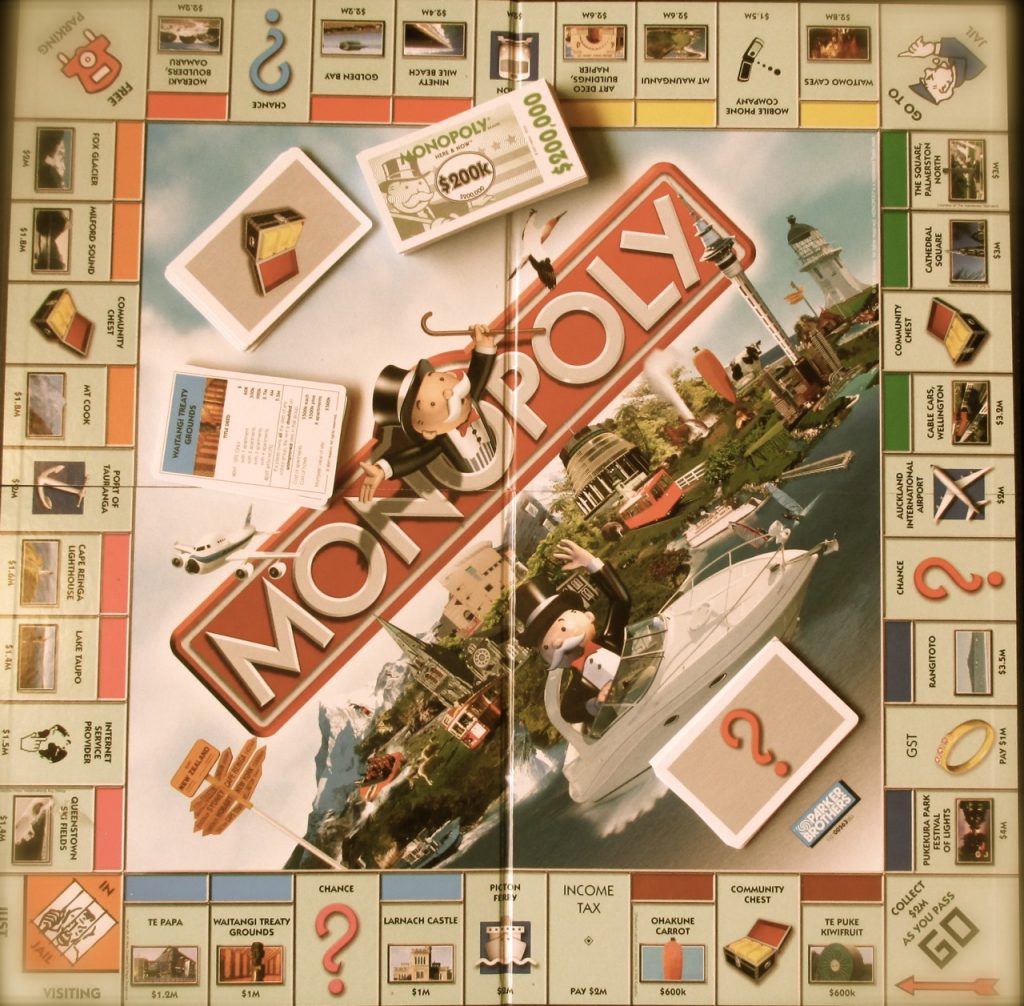
Therefore, Labour Cola’s three sacred cows are shown to be Pepsi National’s elephantine room-mates. Centralized Power, Neo-Colonial Capitalism and a Debt-Tax Cow Enslavement System work together to curb bona fide freedom of New Zealand’s Tax Cattle Kiwis and Iwis.
=====
Steve ‘Snoopman’ Edwards is a dissident journalist, a news and current affairs editor, and a bookworm. His ground-breaking thesis, “It’s the Financial Oligarchy, Stupid“, on the Global Financial Crisis, the UK and US Bank Bail-outs of 2007-2008 and the propagandist news coverage – located the crisis as an exemplar of Shock Doctrine financial engineering, in accordance with a brazen Boom-Bust-Bail-Out Formula.
Source References:
[1] David Bollier. (December 18, 2013). A New Movement for Community Self-Determination. http://www.resilience.org/stories/2013-12-18/a-new-movement-for-community-self-determination-over-corporate-rights/; Creative Spirits. Principles of self-determination. https://www.creativespirits.info/aboriginalculture/selfdetermination/principles-of-self-determination
[2] Hutchinson, F. (1998). What Everyone Really Wants To Know About Money. Charlbury, England: Jon
Carpenter; Stefan Molyneux. (2010). Human Farming: The Story of Your Enslavement https://www.youtube.com/watch?v=Xbp6umQT58A
[3] Gillian Lawrence. (March 2008). The Reserve Bank, private sector banks and the creation of money and credit. Reserve Bank of New Zealand: Bulletin, Vol. 71, No. 1.; Rowbotham, M. (1998). The Grip of Death: A Study of Modern Money, Debt Slavery and Destructive Economics, p. 4, 26. Charlbury, England: Jon Carpenter; Still, W.T. (2009). The Secrets of Oz [Motion Picture] The Money Masters. Retrieved from: http://www.themoneymasters.com/; Brown, E. H. (2008). The Web of Debt: The Shocking Truth About Our Money System and How We Can Break Free (2nd ed.). Baton Rouge, LA: Third Millennium Press; Griffin, G. E. (2008). The Creature from Jekyll Island: A Second Look at the Federal Reserve (4th ed.). Westlake Village, CA: American Media; Grignon, P. (2009). Money as Debt II: Promises Unleashed. http://www.moneyasdebt.net/; Hudson, Michael. (2012). The Road to Debt Serfdom. In: Finance Capitalism and its Discontents, p. 16. Dresden: Islet-Verlag; Michael Hudson. (23 September 2012). Michael Hudson: Money & Debt. ModernMoneyNetwork. Retrieved from: https://www.youtube.com/watch?v=cCsxKy6Lbvg; Mike Maloney. (2013). The Biggest Scam in the History of the World – Mike Maloney Ep 4. Retrieved from: https://www.youtube.com/watch?v=iFDe5kUUyT0; Rowbotham, M. (2000). Goodbye America!: Globalization, Debt and the Dollar System. Charlbury, England: Jon Carpenter; Ott, M. (1982, May). Money, credit and velocity. Review, Federal Reserve Bank of St. Louis, 21-34.
[4] Positive Money NZ. http://www.positivemoney.org.nz/; Living Economics NZ. www.le.org.nz/
[5] Knuth, E. C. (1944). The Empire of the City; Eustace Mullins. (1919). The Secrets of the Federal Reserve: The London Connection. Carson City, Nevada, USA: Bridger House Publishers; Executive Intelligence Review. (Editors). (2010). Dope, Inc.: Britain’s Opium War Against the World. Joshua Tree, California, USA: Progressive Press.com.
[6] Stefan Molyneux. (2010). Human Farming: The Story of Your Enslavement https://www.youtube.com/watch?v=Xbp6umQT58A
[7] RNZ. (1 August 2017). As it happened: Jacinda Ardern takes charge as Labour leader. http://www.radionz.co.nz/news/political/336241/as-it-happened-jacinda-ardern-takes-charge-as-labour-leader
[8] Redline on the Labour Party
[9]Alister Barry(14 October 2004). Someone Else’s Country & Land of Plenty. http://www.hotairfilm.co.nz/ http://www.scoop.co.nz/stories/HL0410/S00166.htm; Redline on the Labour Party; Philip Ferguson (September 12, 2011). Workers, unions and Labour: unravelling the myths. Redline Blog; Barry, Alister. (1995). Someone Else’s Country. [Motion Picture].
Vanguard Films. Retrieved from http://www.nzonscreen.com/title/someone-elses-country-1996;
Barry, Alister. (2002). In a Land of Plenty. [Motion Picture].
Vanguard Films. Retrieved from http://www.nzonscreen.com/title/in-a-land-of-plenty-2002 [In 5-part
video segments]
[10] Jane Kelsey. (2015). The FIRE Economy, p. 49.
[11] Marcia Russell. (1996). Revolution: New Zealand from Fortress to Free Market. p. 57. Mairangi Bay; New Zealand: Hodder Moa Beckett.
[12] Jane Kelsey. (2015). The FIRE Economy.
[13] Palan, R., Murphy, R., & Chavagneux, C. (2010). Tax Havens: How Globalization Really Works. Ithaca, NY: Cornell University Press.; Carroll, W. K. (2010). The Making of a Transnational Capitalist Class: Corporate Power in the 21st Century. London: Zed Books; Shaxson, N. (2011). Treasure Islands: Uncovering the Damage of Offshore Banking and Tax Havens. New York, NY: Palgrave Macmillan; Chris Vellacott. (22 July 2012). Super rich hold $32 trillion in offshore havens http://www.reuters.com/article/us-offshore-wealth-idUSBRE86L03U20120722; Heather Stewart. (21 July 2012). £13tn hoard hidden from taxman by global elite https://www.theguardian.com/business/2012/jul/21/global-elite-tax-offshore-economy
[14] Palan, R., Murphy, R., & Chavagneux, C. (2010). Tax Havens: How Globalization Really Works. Ithaca, NY: Cornell University Press.; Carroll, W. K. (2010). The Making of a Transnational Capitalist Class: Corporate Power in the 21st Century. London: Zed Books; Peter Phillips and Kimberly Soeiro. (August 14, 2012). The Global 1%: Exposing the Transnational Ruling Class. Global Research. Retrieved from: http://www.globalresearch.ca/the-global-1-exposing-the-transnational-ruling-class/32356; Phillips, Peter & Osborne, Brady (2013, September 13). Exposing the Financial Core of the Transnational Capitalist Class. Global Research. Retrieved from http://www.globalresearch.ca/exposing-the-financial-core-of-the-transnational-capitalist-class/5349617; Kwame Nkurumah. (1965). Neo-Colonialism: The Last Stage of Imperialism.
[15] Engdahl, W. (2004). A Century of War: Anglo-American Oil Politics and the New World Order (Rev. ed.), 127-141. London, England: Pluto Press; Engdahl, F. W. (2009).Gods of Money: Wall Street and the Death of the American Century, p. 265-272. Wiesbaden, Germany: edition.engdahl; Estulin, D. (2009). The True Story of the Bilderberg Group (North American Union ed.), p. 183-184. Walterville, OR: Trine Day LLC.
[16] Caley Callahan. (10/03/2017). New Zealand housing most unaffordable in the world – The Economist. http://www.newshub.co.nz/home/money/2017/03/new-zealand-housing-most-unaffordable-in-the-world-the-economist.html; The Economist (Mar 11th 2017).https://www.economist.com/blogs/graphicdetail/2017/03/daily-chart-6; THE DATA TEAM. (Mar 9th 2017). Global house prices. https://www.economist.com/blogs/graphicdetail/2017/03/daily-chart-6
[17] Rosanna Price. (3 June 2016). One in 100 Kiwis homeless, new study shows numbers quickly rising. http://www.stuff.co.nz/national/80719962/One-in-100-Kiwis-homeless-new-study-shows-numbers-quickly-rising
[18] NBR Rich List 2017.
[19] William Tell and The Templar Nation | Atlantis Rising Magazine Library. https://atlantisrisingmagazine.com/article/william-tell-and-the-templar-nation/
[20] The corporate raiders, who made their fortune on the privatizations such as the Bank of New Zealand, Tranz Rail and Telecom, have bolt-holes on the Great Mercury Island, which they acquired in 1978 in circumstances that have never been explained. See: NZ Herald. (15 Oct, 2004 ). The merchant banker’s banker http://www.nzherald.co.nz/business/news/article.cfm?c_id=3&objectid=3601127; Michael Reddell • 29/03/2016 Switzerland of the South Pacific: cargo cult thinking? Croaking Cassandra
[21] Jesson. (1999). Only Their Purpose is Mad, p. 112-113.
[22] Jane Kelsey. (2015). The Fire Economy: New Zealand’s Reckoning, p. 48. Wellington, New Zealand: Bridget Williams Books.
[23] Engdahl, W. (2004). A Century of War: Anglo-American Oil Politics and the New World Order (Rev. ed.), 127-141. London, England: Pluto Press; Engdahl, F. W. (2009). Gods of Money: Wall Street and the Death of the American Century, p. 265-272. Wiesbaden, Germany: edition.engdahl; Estulin, D. (2009). The True Story of the Bilderberg Group (North American Union ed.), p. 183-184. Walterville, OR: Trine Day LLC
[24] Robert Muldoon and the New Zealand economic crisis, 1975-84, p. 10-15. https://apebhconference.files.wordpress.com/2009/08/mcaloon1.pdf
[25] Revolution: Part One – Fortress New Zealand https://www.youtube.com/watch?v=JZXpeUQ0tD8
[26] John Roughan (3 August 2005). July 1984: When life in NZ turned upside down. Retrieved from http://www.nzherald.co.nz/john-roughan/news/article.cfm?a_id=5&objectid=3576219
[27] Notable New Zealanders: The Pictorial Who’s Who, p. 332. First Edition. Auckland: Paul Hamlyn Limited; Eric Pace (5 August 1992). Sir Robert Muldoon Is Dead at 70; Ex-New Zealand Prime Minister http://www.nytimes.com/1992/08/05/world/sir-robert-muldoon-is-dead-at-70-ex-new-zealand-prime-minister.html; Simon Walker. (6 August 1992). Obituary: Sir Robert Muldoon http://www.independent.co.uk/news/people/obituary-sir-robert-muldoon-1538341.html
[28] Revolution: Part One – Fortress New Zealand https://www.youtube.com/watch?v=JZXpeUQ0tD8; Barry, Alister. (1995). Someone Else’s Country. [Motion Picture]. Vanguard Films. Retrieved from http://www.nzonscreen.com/title/someone-elses-country-1996; Barry, Alister. (2002). In a Land of Plenty. [Motion Picture]. Vanguard Films. Retrieved from http://www.nzonscreen.com/title/in-a-land-of-plenty-2002 [In 5-part video segments]
[29] Kelsey, Jane. (1995). The New Zealand Experiment: A World Model for Structural Adjustment? Pluto Press.
[30] Marcia Russell. (1996). Revolution, p. 54-57.
[31] Marcia Russell. (1996). Revolution, p. 65-68.
[32] The Nazi-financing Wall Street banks included: the Chase National Bank (now JP Morgan Chase); the Schroeder-Rockefeller Company; the Manhattan Bank; the National City Bank of New York (now Citibank); the New York Trust Company; V. A. Harriman & Co. and Dillon & Read. Additionally, a Wall Street bank, the Union Banking Corporation, acted as a conduit for funds between the United States and Germany for Nazi financier and steel magnate Fritz Thyssen. A director of the Union Banking Corporation was Prescott Bush a father of former CIA Director George H. W. Bush, who was the vice-president in the Reagan regime at the time of political-economic coup occurring in New Zealand.
[33] Marcia Russell. (1996). Revolution, p.67.
[34] Bryan, D. & Rafferty, M. (2006). Capitalism with Derivatives: A Political Economy of Financial Derivatives, Capital and Class, p.106-107. New York, NY: Palgrave Macmillin.
[35] Marcia Russell. (1996). Revolution: New Zealand from Fortress to Free Market, p. 58, fn 2. Memo: Roger Douglas to Policy Council Members, 13 February 1984.
[36] Marcia Russell. (1996). Revolution, p. 79-80.
[37] (Russell 1996, 101-105).
[38] Robert Barwick et al. (January-March, 1997). Her Majesty’s Mont Perelin Society assaults New Zealand, p. 6-11. In: Nazi ‘reforms’ rip apart New Zealand – Australia Next. The New Citizen Report. Vol.4, No. 7. Citizens Electoral Council, Australia.
[39] Marcia Russell. (1996). Revolution: New Zealand from Fortress to Free Market. p. 230. Mairangi Bay; New Zealand: Hodder Moa Beckett.
[40] Dame Anne Salmond: A final, brief election thought https://www.newsroom.co.nz/2017/09/20/49103/dame-anne-salmond-a-final-brief-election-thought; George Monbiot. (15 April 2916). Neoliberalism – the ideology at the root of all our problems. https://www.theguardian.com/books/2016/apr/15/neoliberalism-ideology-problem-george-monbiot
[41] Nitzan, J. & Bichler, S. (2009). Capital as Power: A Study of Order and Creorder. New York, NY: Routledge. Retrieved from: bnarchives.yorku.ca/259/2/20090522_nb_casp_full_indexed.pdf; Tim DiMuzio (28 November 2013). The Weekly Sabotage: Week 1. Capital as Power. http://www.capitalaspower.com/2013/11/the-weekly-sabotage-week-1/
[42] Brian Fallow. (27-28 February 1999). QC blames tax officials for fraud case failings. The Weekend Herald.
[43] Katyal, N. K. (2002). Conspiracy theory, p. 1314-1316 The Yale Law Journal, 112, 13071398. Retrieved from http://yalelawjournal.org/; Marcus, P. (1977). Conspiracy: The criminal agreement, in theory and practice, p. 932-933. The Georgetown Law Journal, 65, 925-969. Retrieved from http://www.georgetownlawjournal.org/
[44] Katyal, N. K. (2002). Conspiracy theory. The Yale Law Journal, 112, 13071398. Retrieved from http://yalelawjournal.org/
[45] Alistair Barry. (2008). The Hollow Men. [Documentary]. Retrieved from www.nzonscreen.com/title/the-hollow-men-2008; Barry, Alistair. (2002). In a Land of Plenty. [Motion Picture]. Vanguard Films. Retrieved from http://www.nzonscreen.com/title/in-a-land-of-plenty-2002 [In 5-part video segments]; See also: Barry, Alistair. (1995). Someone Else’s Country. [Motion Picture]. Vanguard Films. Retrieved from http://www.nzonscreen.com/title/someone-elses-country-1996; Jane Kelsey. (1993). Rolling Back the State, p. 47
[46] Marcia Russell. (1996). Revolution: New Zealand from Fortress to Free Market. p. 133. Mairangi Bay; New Zealand: Hodder Moa Beckett.
[47] Robert Barwick et al. (January-March, 1997). Her Majesty’s Mont Perelin Society assaults New Zealand, p. 9. In: Nazi ‘reforms’ rip apart New Zealand – Australia Next. The New Citizen Report. Vol.4, No. 7. Citizens Electoral Council, Australia.
[48] ’t Hart, P. (1993). Symbols, rituals and power: The lost dimensions of crisis management. Journal of Contingencies and Crisis Management, 1, 36-50. Retrieved from http://www.wiley.com/bw/journal.asp?ref=0966-0879
[49] Jane Kelsey. (1998). The New Zealand Experiment, p. 135
[50] Kelsey 1995; 2015.
[51] Jane Kelsey. (2015). The Fire Economy, p. 51.
[52] Barry, Alistair. (1995). Someone Else’s Country. [Motion Picture]. Vanguard Films. Retrieved from http://www.nzonscreen.com/title/someone-elses-country-1996; Barry, Alistair. (2002). In a Land of Plenty. [Motion Picture]. Vanguard Films. Retrieved from http://www.nzonscreen.com/title/in-a-land-of-plenty-2002 [In 5-part video segments]; Revolution [In 4-part video segments] Television – 1996. Retrieved from https://www.nzonscreen.com/title/revolution-1-fortress-new-zealand-2009
[53] Steven Stillman, Malathi Velamuri and Andrew Aitken. (July 2008). The Long-Run Impact of New Zealand’s Structural Reform on Local Communities, p. 5. Motu Working Paper 08-11. Motu Economic and Public Policy Research. http://motu-www.motu.org.nz/wpapers/08_11.pdf
[54] Marcia Russell. (1996). Revolution: New Zealand from Fortress to Free Market. p. 142. Mairangi Bay; New Zealand: Hodder Moa Beckett.
[55] Douglas, Roger. (1993). Unfinished Business, p. 221 Auckland; New Zealand: Random House.
[56] Marcia Russell. (1996). Revolution, p. 219.
[57] Marcia Russell. (1996). Revolution, p. 220-224.
[58] In a Land of Brain-washed Kiwis – Part 3: The ACT Party’s Covert Role in a Billionaires’ Bolt-hole. https://snoopman.net.nz/2017/09/08/in-a-land-of-brain-washed-kiwis-part-3-the-act-partys-covert-role-in-a-billionaires-bolt-hole/
[59] Shamubeel Eaqub. (13 August 2016). It’s time to include house prices in inflation calculations. http://www.stuff.co.nz/business/opinion-analysis/83106207/Shamubeel-Eaqub-Is-time-to-include-house-prices-in-inflation-calculations; Stats NZ. Home Ownership in the Consumer Price Index. http://www.stats.govt.nz/browse_for_stats/economic_indicators/cpi_inflation/home-ownership-in-the-cpi.aspx
[60] Liam Dann 10 Jun, 2017 Nation of Debt: Half a trillion dollars and still rising http://www.nzherald.co.nz/business/news/article.cfm?c_id=3&objectid=11873204; National Debt Clocks – New Zealand. http://www.nationaldebtclocks.org/debtclock/newzealand
[61] CIA. (25 October 1988). “Racial Tensions: A Growing Factor in New Zealand, p. 3. Politics. Directorate of Intelligence. U.S. Central Intelligence Agency.
[62] Simon Upton quoted in New Zealand Herald, December 30, 1989.
[63] Robert Barwick et al. (January-March, 1997). Her Majesty’s Mont Perelin Society assaults New Zealand, p. 6-11. In: Nazi ‘reforms’ rip apart New Zealand – Australia Next. The New Citizen Report. Vol.4, No. 7. Citizens Electoral Council, Australia.
[64] NBR Rich List 2016. The National Business Review Rich List Index. Ranked Alphabetically, p. 47. National Business Review.
65] Peter D. Hutchison and Kelly Nyks. (2015). Requiem for the American Dream: Noam Chomsky and the Principles of Concentration of Wealth & Power. Retrieved from: https://www.youtube.com/watch?v=j9asVtLFxpU
[66] Naomi. Klein. (2007). The Shock Doctrine; Pilger, J. (2002). The New Rulers of the World. London: Verso; Pilger, J. & Lowry, A. (2001). The New Rulers of the World, Carlton Television, Pinkus, Karen. “Nothing from Nothing: Alchemy and the Economic Crisis.” World Picture 2.
[67] Nitzan, J. & Bichler, S. (2009). Capital as Power: A Study of Order and Creorder. New York, NY: Routledge. Retrieved from: bnarchives.yorku.ca/259/2/20090522_nb_casp_full_indexed.pdf; Tim DiMuzio (28 November 2013). The Weekly Sabotage: Week 1. Capital as Power. http://www.capitalaspower.com/2013/11/the-weekly-sabotage-week-1/
[68] Peter D. Hutchison and Kelly Nyks. (2015). Requiem for the American Dream: Noam Chomsky and the Principles of Concentration of Wealth & Power. Retrieved from: https://www.youtube.com/watch?v=j9asVtLFxpU
[69] Engdahl, W. (2004). A Century of War: Anglo-American Oil Politics and the New World Order (Rev. ed.). London, England: Pluto Press; Engdahl, F. W. (2009). Gods of Money: Wall Street and the Death of the American Century. Wiesbaden, Germany: edition.engdahl; Colonel L. Fletcher Prouty: The Origin of Fossil Fuel & Peak Oil. Retrieved from: https://www.youtube.com/watch?v=2cUg3lDgJ20
[70] Engdahl, W. (2004). A Century of War: Anglo-American Oil Politics and the New World Order (Rev. ed.),127-141. London, England: Pluto Press; Engdahl, F. W. (2009).Gods of Money: Wall Street and the Death of the American Century, p. 265-272; Wiesbaden, Germany: edition.engdahl; Estulin, D. (2009). The True Story of the Bilderberg Group (North American Union ed.), p. 183-184. Walterville, OR: Trine Day LLC
[71] Hutchison and Nyks. (2015). Requiem for the American Dream; Shoup, L. H. & Minter, W. (2004 [1977]). Imperial Brain Trust: The Council on Foreign Relations and United States Foreign Policy, 254-284. New York, NY: Authors Choice Press.
[72] Naomi Klein. (2007). The Shock Doctrine, p. 78.
[73] Peter D. Hutchison and Kelly Nyks. (2015). Requiem for the American Dream: Noam Chomsky and the Principles of Concentration of Wealth & Power. Retrieved from: https://www.youtube.com/watch?v=j9asVtLFxpU
[74] Kwame Nkurumah. (1965). Neo-Colonialism: The Last Stage of Imperialism. London, United Kingdom: Nelson.
[75] Rowbotham, M. (1998). The Grip of Death: A Study of Modern Money, Debt Slavery and Destructive Economics, p. 4, 26. Charlbury, England: Jon Carpenter; Mike Maloney. (2013). The Biggest Scam in the History of the World – Mike Maloney Ep 4. Retrieved from: https://www.youtube.com/watch?v=iFDe5kUUyT0; Ross Ashcroft. (2012). Four Horsemen; The Global Financial Crisi Renegade Films. Retrieved from: https://www.youtube.com/watch?v=5fbvquHSPJU
[76] Mike Maloney. (2013). “The Biggest Scam In The History Of Mankind (Documentary) – Hidden Secrets of Money 4”. Retrieved from https://www.youtube.com/watch?v=iFDe5kUUyT0; SEE ALSO: “The Secret Of Oz” – The Truth Behind The Modern Financial System, And The Money-Political Complex” at: http://www.zerohedge.com/article/secret-oz-truth-behind-modern-financial-system-and-money-political-complex; Paul Grignon (2009). Money As Debt – Full Length Documentary. Retrieved from https://www.youtube.com/watch?v=jqvKjsIxT_8
[77] Rowbothman. (1998). The Grip of Death, p.26.
[78] Ott, M. (1982, May). Money, credit and velocity. Review, Federal Reserve Bank of St. Louis, p. 25.
[79] Greenspan. (1998: 247). As cited in: Allen, R. E. (1999). Financial crises and recession in the global economy, p. 87. Cheltenham, Glos, UK: Edward Elgar.
[80] Hutchinson, F. (1998). What Everyone Really Wants To Know About Money. Charlbury, England: Jon Carpenter; Stefan Molyneux. (2010). Human Farming: The Story of Your Enslavement https://www.youtube.com/watch?v=Xbp6umQT58A
[81] An overview of the functions of money, and how money and credit are created in the NZ economy, examining the roles of the Reserve Bank and private sector banks. http://www.interest.co.nz/opinion/77033/overview-functions-money-and-how-money-and-credit-are-created-nz-economy-examining; How Banks Create Money. http://positivemoney.org/how-money-works/how-banks-create-money/
[82] Engdahl, W. (2004). A Century of War: Anglo-American Oil Politics and the New World Order (Rev. ed.), p. 127-141. London: Pluto Press.
[83] Saskia Sassen (2005). The Global City: introducing a Concept. Brown Journal of World Affairs. https www.saskiasassen.com/pdfs/publications/the-global-city brown.pdf; Robinson, W. I. (2004). A theory of global capitalism: Production, class, and state in a transnational world. Baltimore, MD: John Hopkins University Press; de Angelis, M. (2001, May). Global capital, abstract labour, and the fractal panopticon. The Commoner. Retrieved from http://www.commoner.org.uk/fractalpanopt.pdf
[84] Barry, Alistair. (2002). In a Land of Plenty. [Motion Picture]. Vanguard Films. Retrieved from http://www.nzonscreen.com/title/in-a-land-of-plenty-2002 [In 5-part video segments]
[85] New Zealand Unemployment Rate | 1985-2017. https://tradingeconomics.com/new-zealand/unemployment-rate
[86] Barry, Alistair. (2002). In a Land of Plenty. [Motion Picture]. Vanguard Films. Retrieved from http://www.nzonscreen.com/title/in-a-land-of-plenty-2002 [In 5-part video segments]
[87] Barry, Alistair. (1995). Someone Else’s Country. [Motion Picture]. Vanguard Films. Retrieved from http://www.nzonscreen.com/title/someone-elses-country-1996; Barry, Alistair. (2002). In a Land of Plenty. [Motion Picture]. Vanguard Films. Retrieved from http://www.nzonscreen.com/title/in-a-land-of-plenty-2002 [In 5-part video segments].
[88] Bruce, B. (Director & Writer). Inside Child Poverty. Red Sky Television. Retrieved from https://www.youtube.com/watch?v=0AnC8yMph78
[89] Rosanna Price. (3 June 2016). One in 100 Kiwis homeless, new study shows numbers quickly rising. http://www.stuff.co.nz/national/80719962/One-in-100-Kiwis-homeless-new-study-shows-numbers-quickly-rising
[90] Kate Shuttleworth. 606 pairs of empty shoes: the growing toll of suicide in New Zealand. 606 pairs of empty shoes: the growing toll of suicide in New Zealand | World news | The Guardian. https://www.theguardian.com/world/2017/sep/01/606-empty-shoes-growing-toll-suicide-new-zealand
[91] NZ’s unemployment rate drops below 5 percent | Radio New Zealand http://www.radionz.co.nz/news/business/330021/nz%27s-unemployment-rate-drops-below-5-percent
[92] Employment: Why is this important for social statistics? http://www.stats.govt.nz/browse_for_stats/snapshots-of-nz/nz-social-indicators/Home/Labour%20market/employment.aspx
[93] Bruce, B. (Director & Writer). (2013). Mind The Gap: A Special Report on Inequality [Motion Picture]. Red Sky Television. Retrieved from http://www.tv3.co.nz/INSIDE-NEW-ZEALAND-Mind-The-Gap/tabid/3692/articleID/94816/MCat/3061/Default.aspx
